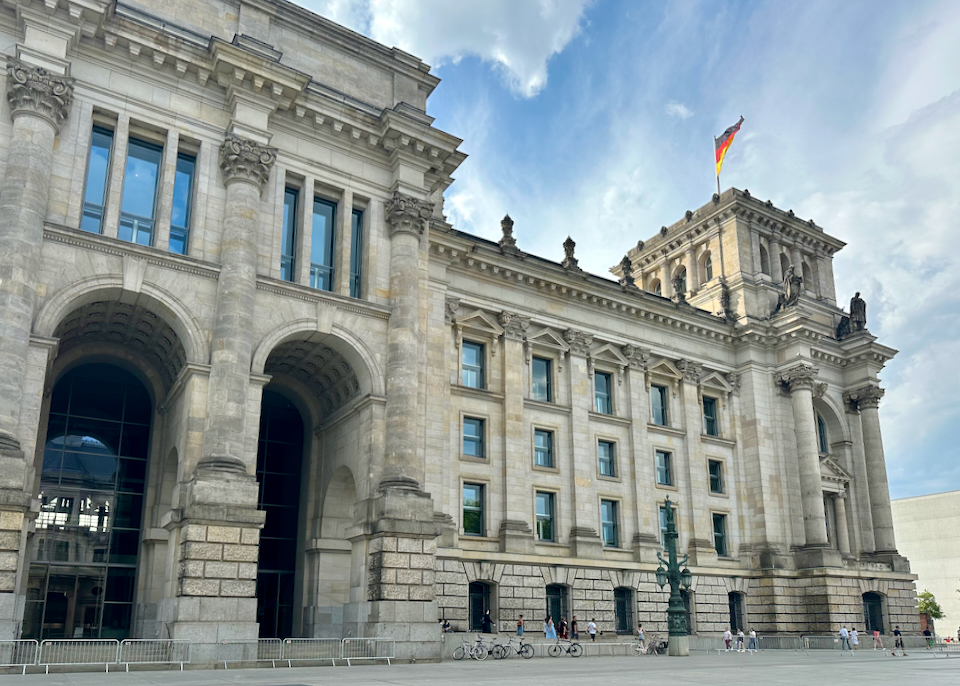
The Reichstag (German Parliament) building in Mitte West. The 5-star Adlon Kempinski – our favorite luxury hotel in Berlin – is located just around the corner from here.
The Best Areas to Stay in Berlin
There is perhaps no other city in Europe whose recent history is so brutal and so famous as Berlin’s, and widespread knowledge of World War II and Cold War history makes a trip to Berlin, for most, a fascinating and moving experience. But while there are plenty of memorials to be found here, the city is far from stuck in its past. Modern Berlin is a vibrant, exciting, and international city that explodes with art, activism, and bonhomie. Even so, the best place to start is with those must-see historical sights, both because they truly are breathtaking and because most of them are found in Berlin-Mitte, the metaphorical and geographical heart of the city. Literally meaning ‘middle’, this area is packed with so many famous attractions that it’s helpful to split it up into west (Unter den Linden), central, east (Museumsinsel to Alexanderplatz), south (Potsdamer Platz and around), and north (Spandauer Vorstadt) section.
The iconic Brandenburg Gate in West Mitte, built in the 18th century, once symbolized the division of the city during the Cold War and now stands as a powerful symbol of German unity and peace.
Berlin Neighborhoods
In West Mitte, the grand Unter den Linden boulevard runs through the center of Berlin and boasts the Reichstag (German Parliament) and the iconic Brandenburger Tor (Brandenburg Gate) at its westernmost end. Unter den Linden turns into Bundesstrasse as it heads east past Museumsinsel in Central Mitte (Museum Island, home to five world-class museums and the Berliner Dom cathedral) and into East Mitte, passing the DDR Museum, Nikolaiviertel (the medieval center of Berlin), the Fernsehturm (TV Tower) and, finally, the sweeping Alexanderplatz.
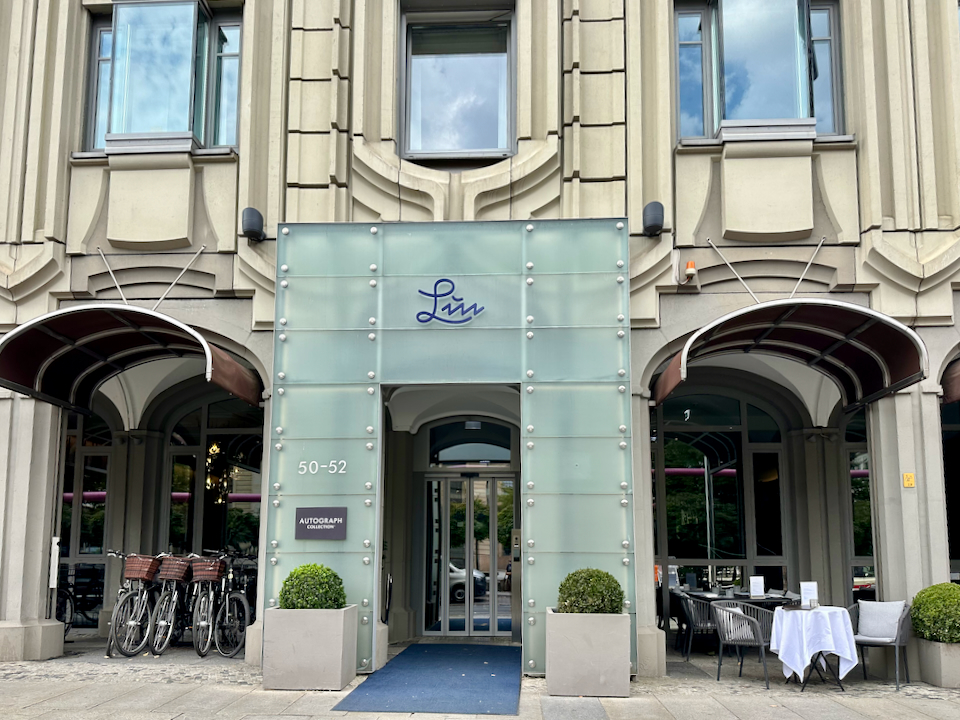
The wonderful Hotel Luc in West Mitte sits right on the Gendarmenmarkt, one of Germany’s most picturesque public squares; some rooms feature great views over its beautiful neoclassical buildings.
To grasp the vibe of Southern Mitte, head to Potsdamer Platz, whose glittering glass skyscrapers and modern architecture are a heartening symbol of the city’s resilience (the area was totally destroyed in the war and left like a wasteland for decades). Culture lovers will want to visit the Kulturforum, home to the Philharmonie concert hall and the Gemäldegalerie, one of the best collections of European art in the world.
In North Mitte, just past Alexanderplatz and Museumsinsel, is the neighborhood known as Spandauer Vorstadt – or sometimes Hackescher Markt, after its best shopping area. Spandauer Vorstadt includes the former Jewish quarter; the Neue Synagoge (New Synagogue) and its magnificent gilded dome stand testament to the period when a burgeoning Jewish population made an enormous contribution to the fabric of Berlin life. The area is also known for its many Höfe (courtyards), which are filled with independent boutiques and dining options.
Neue Synagogue
Prenzlauer Berg lies just to the north of Mitte, and, while it has its own attractions like the Kulturbrauerei and the Mauerpark (where the city’s favorite flea market is held every Sunday), it is similar to Hackescher Markt in that there are endless independent stores, restaurants, cafes, and bars to explore, and walking down almost any street in either neighborhood will feel like you are uncovering local gems. On the cusp of Prenzlauer Berg and Mitte is one of the city’s unmissable highlights, the Gedenkstätte Berliner Mauer (Berlin Wall Memorial), which is less of a memorial than an outdoor museum telling the story of the Wall and its horrific repercussions.
For those whose first thoughts of Berlin are not about war and division but of its epic 24-hour nightlife, street art, and general grittiness, head to Friedrichshain-Kreuzberg. These two distinct neighborhoods share a punky, alternative feel, despite the fact they were once separated by the Berlin Wall. Local highlights include the Jewish Museum and the East Side Gallery – original sections of the Berlin Wall painted with murals.
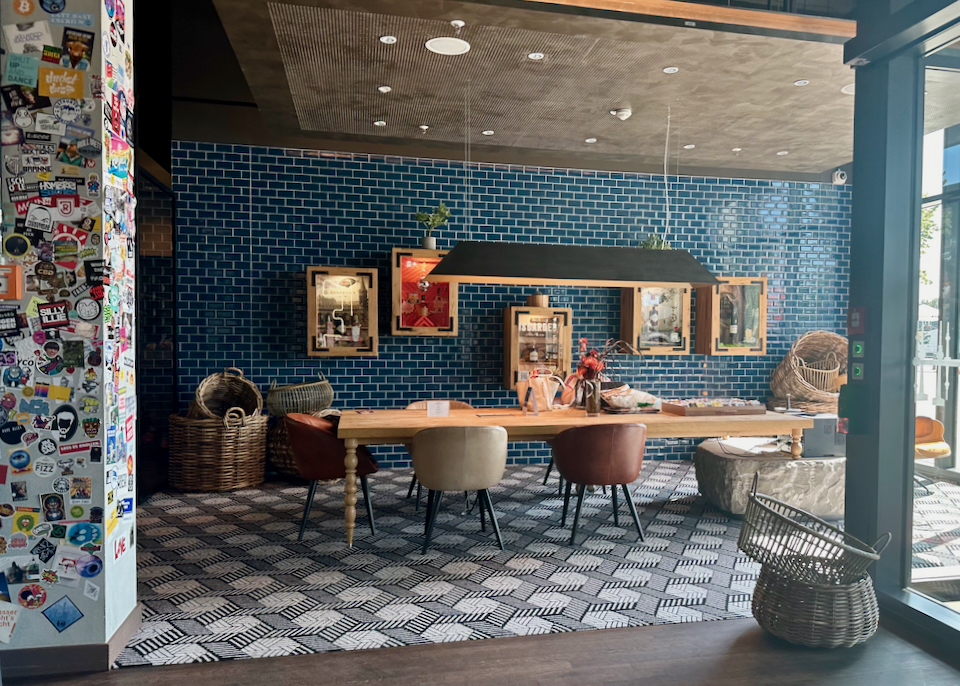
We like the funky but polished vibe – and nice river views – at the Indigo East Side Gallery hotel in Friedrichshain.
Brandenburger Tor is one of the gateways into the Tiergarten, the enormous park crammed with attractions ranging from the Soviet War Memorial and iconic Siegessäule (Victory Column), to beer gardens and the Berlin Zoo; either spend a day wandering around or take the #100 bus through it, which goes past most of the highlights. West of the park is genteel Charlottenburg, once the heart of free West Berlin. Do not miss the Kaiser-Wilhelm-Gedächtniskirche (Kaiser Wilhelm Memorial Church), which was left in its bombed-out state to testify to the devastation of war. The church also marks the top of Kurfürstendamm, the most famous shopping street in Berlin. One of the area’s main draws is Schloss Charlottenburg (Charlottenburg Palace), whose many opulent rooms and annexes set in glorious gardens make a wonderful day trip to learn about Prussian history. Opposite the palace are three world-class art galleries, including the Surrealism heaven Sammlung Scharf-Gerstenberg.
Getting Around Berlin
While it’s relatively easy to explore Berlin’s historic center on foot, it’s a very big city and you’ll want to use its excellent public transport system to go further afield. BVG operates an integrated system of U-and S-Bahn train lines, buses, and trams. Single tickets start at €3 for the center, with the 24-hour ticket (€8.80) a much better value if you intend to make three trips or more.
Bikes abound in Berlin’s Prenzlauer district.
Bike, e-bike, and e-scooter rental is available through several bikeshare schemes including Tier and Next Bike, Bolt, LimeBike, and Donkey Republic. Berlin is not a bad place to ride bikes, with hundreds of miles of bike lanes and paths, and mostly flat terrain.
The Best Places to Stay in Berlin
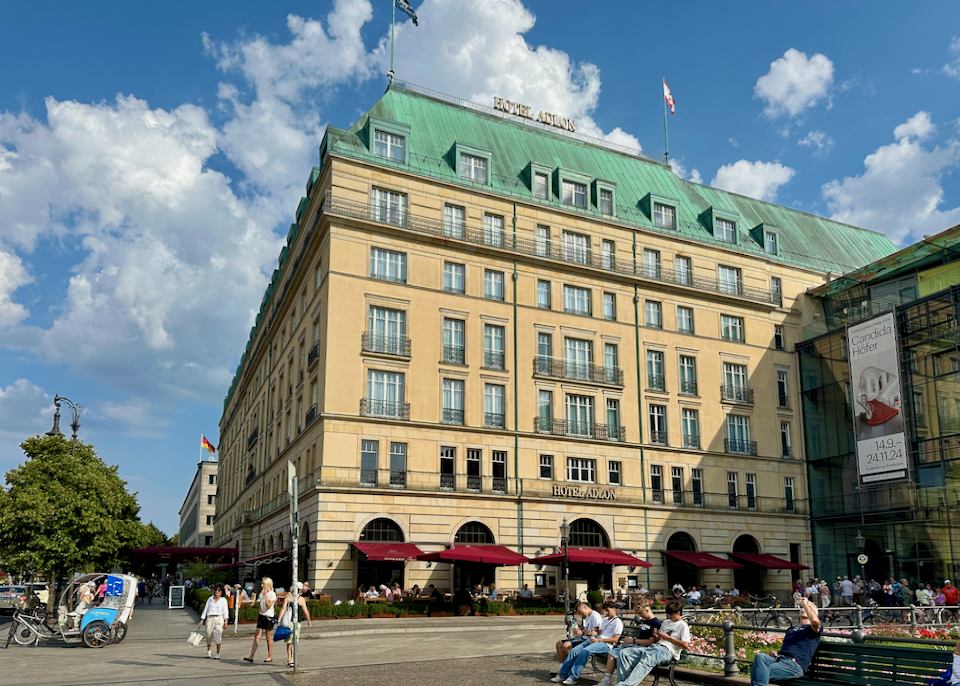
The marvelous Adlon Kempinski is located steps from the Brandenburg Gate.
- Best Luxury Hotels in Berlin
Adlon Kempinski • Ritz-Carlton • Hotel Luc • Roomers Berlin Steinplatz • Westin Grand- Best Boutique Hotels in Berlin
Adelante Boutique Hotel • Casa Camper • The Gate Garden • The Mandala • Mittendrin • Wil7 Boutique Hotel- Best Cheap & Midrange Hotels in Berlin
Adina Apartment Hotel • Boutique-Hotel Kerlin • Clipper Boardinghouse-Gendarmenmarkt • Grimm’s Potsdamer Platz • Hotel Q! • Hüttenpalast • Pestana Berlin TiergartenGrimm’s is a comfortable, good value hotel with a boutique vibe and rooftop terrace near Potsdamer Platz.
Best Areas in Berlin for…
- Best Area in Berlin for Sightseeing: Mitte
Almost all the blockbuster sights are in Mitte, which covers everything from Potsdamer Platz and Checkpoint Charlie in the south to the Berlin Wall Memorial in the north, the Brandenburg Gate and the Reichstag in the west, and TV Tower and Alexanderplatz in the east. If those are not enough, there are also the Unter den Linden boulevard, and Museum Island (home to the Dom as well as the Alte National galerie, Altes Museum, Bode-Museum, Neues Museum, and the Pergamonmuseum).Alte Nationalgalerie on Museum Island showcases an impressive collection of Neoclassical, Romantic, and Impressionist art; including works by Caspar David Friedrich, Adolph Menzel, and Claude Monet.
Just over the Karl-Liebknecht-Brücke bridge are the DDR Museum and Nikolaiviertel. And, to the north of Alexanderplatz and Museumsinsel, there’s the wonderful Hackescher Markt with its endless shopping in characterful courtyards. There are so many sights in Mitte that you could easily spend a week in this area alone, so do your research and preserve your energy by hitting only those you’re most interested in.
The Hackesche Höfe is a beautifully restored complex of interconnected courtyards in Berlin’s Mitte district. Built in the early 20th century, it features striking Jugendstil (Art Nouveau) architecture and a mix of shops, cafes, galleries, cinemas, and offices.
- Best Area in Berlin for Nightlife: Kreuzberg & Friedrichshain
For a great night out, head to Kreuzberg or Friedrichshain, which have kept the good vibes flowing, despite the developers who are moving in threatening to put an end to the party. Berlin has many 24-hour joints, especially over the weekend, so don’t be surprised if you find yourself in what you think is a bar that suddenly turns into a nightclub, or a club that suddenly starts drawing in the brunch crowd. In Kreuzberg, one of the liveliest hubs is around Kottbusser Tor (known affectionately by locals as ‘Kotti’), especially along Dresdener Strasse, Oranienstrasse, and around Markthalle Neun, which is especially buzzing on “Streetfood Thursday” each week, when the market stays open late.Over the bridge in Friedrichshain, a good place to start is Warschauer Strasse, which is always alive with people coming and going. Down below the station, in the old train maintenance plant, is RAW-Gelände, a sprawling complex of micro-businesses (an outdoor cinema, a climbing wall, several food stalls). All around this area, especially the streets north leading to Boxhagener Platz, there are several great bars and restaurants. One of the most famous nightclubs in the world, Berghain, is in Friedrichshain, although it is notoriously tricky to get into thanks to its strict door policy.
RAW-Gelände in Friedrichshain is home to renowned clubs like Cassiopeia and Suicide Circus (Lokschuppen Berlin).
- Best Areas in Berlin for Food and Restaurants: Kreuzberg, Prenzlauer Berg
As a melting pot of cultures, pretty much every taste is catered for in Berlin, though it’s not known for its showy gourmet restaurants; the best spots tend to be no-frills neighborhood joints. Some of the most popular are kebab stalls like RüyamGemüse Kebab in Schöneberg and Mustafa Demir’s Gemüse Kebap in Friedrichshain, and Burgermeister Schlesisches Tor burger stand in Kreuzberg, not to mention numerous purveyors of local favorite “currywurst” (fried sausage smothered with curry powder or curry sauce).Kreuzberg is our overall favorite neighborhood for eating, especially for an incredible selection of street food: the myriad stalls inside the Markthalle Neun is the best place to start. For a splurge go to Restaurant Tim Raue, or Nobelhart & Schmutzig; Alt Berliner Wirtshaus Henne (aka Die Henne) for traditional German dishes; and Adana Grillhaus and Izmir Köfte for delicious Turkish snacks and kebabs.
Prenzlauer Berg is another good place to go, where you’ll find tons of great options on Oderberger Strasse, Kollwitzplatz, and Kastanienallee, as well as great German food at the seasonal Prater Beer Garden, Metzer Eck, and Leibhaftig (not forgetting currywurst at Konnopke’s Imbiss).
- Best Areas in Berlin for Families: Mitte and Charlottenburg
Berlin has loads of great stuff for kids but they’ll have the best time in Mitte. They can ascend the Fernsehturm or take Europe’s fastest elevator up to the Panoramapunkt; find Legoland in the dazzling Sony Center; see the recreated section of the Berlin Wall at the Gedenkstätte Berliner Mauer; learn about life in East Berlin at the interactive DDR Museum; learn about natural history at the Museum für Naturkunde; and pose for a picture at the sandbags by Checkpoint Charlie.Another child-friendly area is Charlottenburg. Not only does it border the Tiergarten, but the Berlin Zoologischer Garten (zoo) is in one corner of the park, while the nearby Bikini Berlin mall is perfect for teens. Children of all ages will be blown away by Schloss Charlottenburg’s bling and its enormous gardens. Finally, be sure to take them on the double-decker #100 bus, which goes from the zoo, right through the Tiergarten, and all around Mitte to Alexanderplatz, to see how many of the sights they can remember.
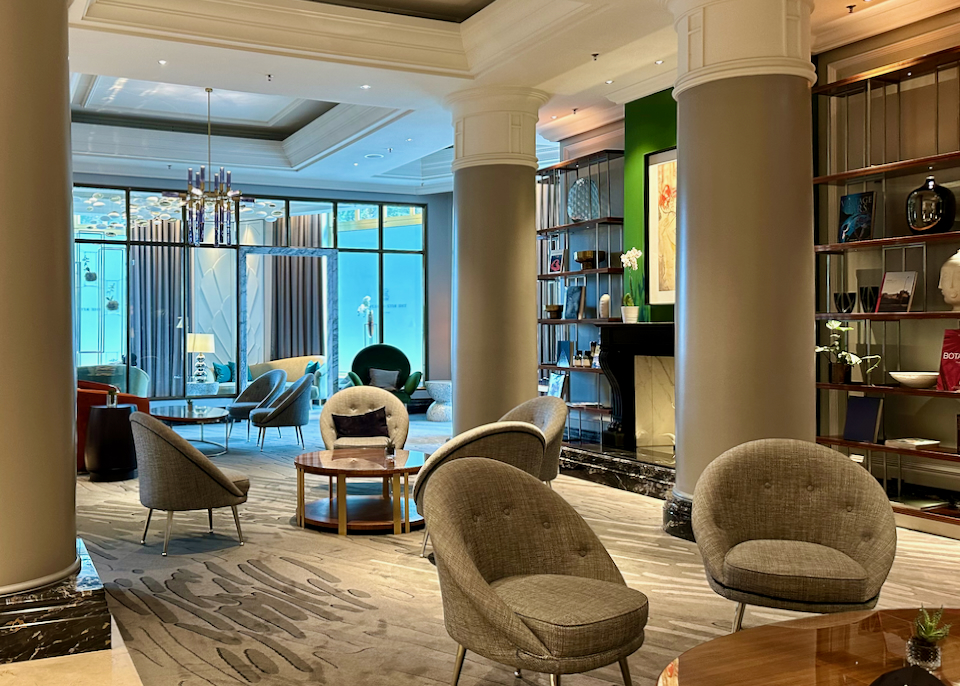
The Ritz-Carlton is one of the best luxury hotels in Berlin. It has an indoor pool and sits directly across from Potsdamer Platz’ Sony Center and Lego Land in Mitte South – making it a great choice for families.
- Best Area in Berlin to Stay for First Timers: Mitte
First-timers really should get the basics out of the way and “do” Mitte’s biggest sights: the Brandenburger Tor, the Reichstag, Museumsinsel (especially the Pergamon), and Fernsehturm/Alexanderplatz. Complete your top 5 by taking a stroll through the Tiergarten, pausing to check out the Soviet memorial and the Victory Column. If you have any time after that, the number-one sight worth traveling to is the Gedenkstätte Berliner Mauer. The outdoor museum dedicated to the Berlin Wall not only has large stretches of the original wall, but it also has a full-scale recreation of its final incarnation, with its double-wall and extended buffer zone, complete with a guard tower. A great bonus to walking along the whole of the memorial is that it goes through interesting neighborhoods – the eastern end is at Mauerpark in Prenzlauer Berg, where a huge flea market is held every Sunday.The grafitti-covered Haus Schwarzenberg in North Mitte is a unique cultural enclave that houses independent galleries and museums – including one dedicated to Anne Frank.
- Most Romantic Areas in Berlin: By the water
Berlin is laced with waterways, and Berliners love to swim in summer. Whether you go for a picnic by the river, wander along a canal at sunset, or do a day trip to one of the massive lakes that are dotted all around the city – romantic waterside opportunities abound. The River Spree can feel quite overshadowed by the wonders on land, but there are some very lovely spots: try crossing over the Monbijoubrücke from the northernmost tip of Museumsinsel and strolling along the Berliner Uferpromenade in Monbijou Park; explore tiny Insel der Jugend, an island in the Spree southeast of Kreuzberg; have a drink by the Tiergarten’s biggest lake at the Café am Neuen See; or take a dip in the Badeschiff, a floating public pool in Kreuzberg. Another option would be the Böcklerpark along the Landwehr Canal, also in Kreuzberg; it’s a really popular spot with locals hoping to catch the sunset.For those with more time in Berlin and can get out of the city, a trip to one of the lakes or rivers on the city’s outskirts is a must. Try Klein-Venedig (Little Venice) on the Havel, and the adjacent Wannsee, around 45 minutes from Mitte via public transport, where you can lounge on the “beach” by the Art Deco lido, explore secluded spots in forested areas, take boat trips, and discover places to eat and drink.
- Best Areas in Berlin for a Local Vibe: Kreuzberg, Friedrichshain, Prenzlauer Berg
The best way to understand the Berlin lifestyle is to make time to live it. Take a dip in the Badeschiff or drink a can of craft beer by the Landwehr Canal in Kreuzberg at sunset. In Friedrichshain, walk the whole of Karl Marx Allee to see how the former Communist grand boulevard has adapted to capitalist life, or take a gamble on getting into Berghain (even a rejection by the strict door staff will be a classic Berlin experience). Enjoy the babble of different languages spoken by the children playing in the Kollwitzplatz, or spend Sunday at the Mauerpark flea/karaoke in Prenzlauer Berg. Or, simply get a drink and sit outside a “späti” (small stores that stay open late into the night with tables outside) in any neighborhood. There are as many local vibes in Berlin as there are Berliners, so do as they do and make your own fun.With over 400 stalls offering vintage clothing, antiques, vinyl records, and handcrafted goods, the Mauerpark Flea Market in Prenzlauer Berg is a popular Sunday destination. In addition to treasure hunting, visitors can also enjoy a diverse international street food market and Bearpit Karaoke in the park’s amphitheater.
- Best Area in Berlin for Walking: Tiergarten
The Tiergarten is big. Even if you stick to the main road through the middle and don’t stop anywhere along the way, it will take you a good 40 minutes to walk from east to west.- Safest Area in Berlin
Berlin is generally very safe for tourists. The biggest risk, as in most European cities, comes from pickpockets (especially in Alexanderplatz, Kurfürstendammor on the subway) or muggers, but the likelihood of either of these things happening is low if you aren’t flashy with your possessions and keep an eye on what’s going on around you.
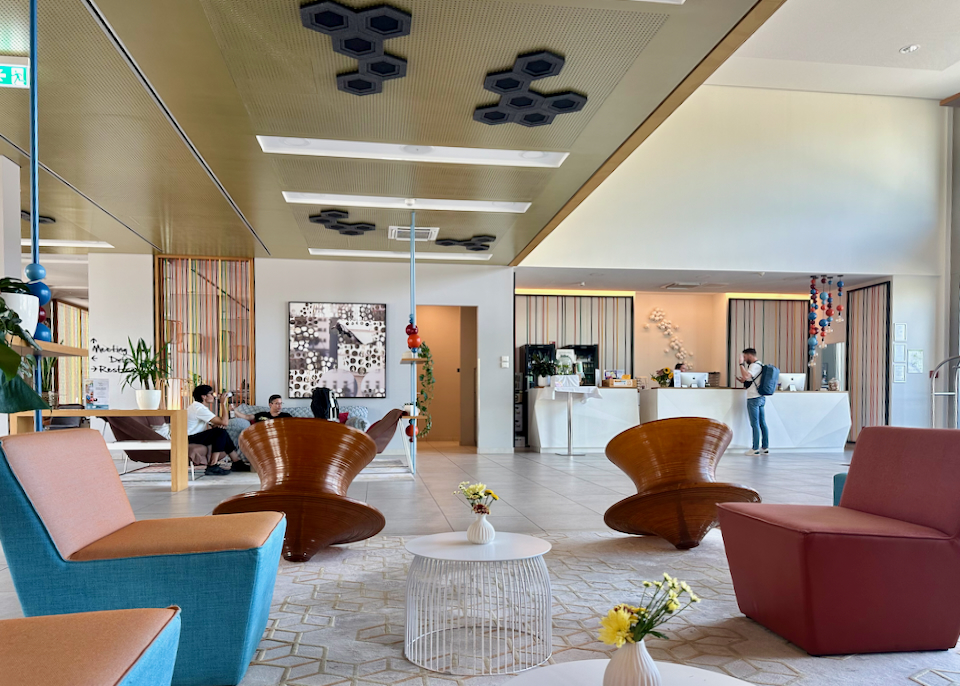
Colorful and comfortable, the 4-star Capri By Fraser hotel is located at the southern end of Museum Island.
The 8 Best Neighborhoods in Berlin for Tourists
1. Mitte West: Unter den Linden (Dorotheenstadt & Friedrichstadt)
Reichstag Building
The western part of Mitte Berlin comprises the historic Dorotheenstadt and Friedrichstadt neighborhoods, south of the River Spree and anchored by the wide Unter den Linden boulevard – though much of the area was destroyed in World War II. Both neighborhoods were developed in the 18th century as an extension of the old town and incorporated into East Berlin during the Cold War. Today, as well as being a major shopping destination, it’s the home of many government ministries and offices. Standing proudly at the top of Unter den Linden and at the start of the Tiergarten is the Brandenburg Gate, the iconic neoclassical monument built under the king of Prussia in the 1790s as part of the plan to make Berlin the “Athens on the Spree”. Topped with its charioteer sculpture, the gate was originally conceived as a peace monument, but its meaning was usurped twice in the 20th century: first by the Nazis as a symbol of their power, and later as a symbol of freedom when the Berlin Wall was torn down in 1989.
Brandonberg Gate
One block north is the 19th-century Reichstag Building (the seat of the German Parliament). Since the 1999 addition of Norman Foster’s inspiring rotunda, which allows the public to oversee the politicians at work in the main chamber below, the Reichstag has become one of the most-visited government buildings in the world. It’s free to visit, but be sure to book well ahead or risk hours in line. Two blocks south is the poignant but controversial Memorial to the Murdered Jews of Europe by Peter Eisenman, comprising a giant field of 2711 stone slabs and a sobering underground museum. Just to the south, in an otherwise unassuming residential estate on Gertrud-Kolmar-Strasse, an information board marks the location of the “Führerbunker”, where Hitler committed suicide in 1945 (the bunker was demolished by the Soviets).
Head east and you’ll reach the Gendarmenmarkt, the old heart of Friedrichstadt and one of Germany’s most beautiful public squares with its symmetrical trio of neoclassical buildings: the Berlin Concert Hall (Konzerthaus), and the 18th-century French and German Cathedrals (the Deutscher Dom and Französischer Dom).
Gendarmenmarkt’s Französischer Dom (French Cathedral)
Nearby, back on Unter den Linden, Bebelplatz is anchored by the Memorial to the 1933 Nazi Book Burning, and is surrounded by rebuilt St. Hedwig’s Cathedral, Berlin State Opera, and the buildings of historic Humboldt University.
Berlin State Opera
The simple but moving Neue Wache (anchored by Käthe Kollwitz’s sculpture Pietá) is a memorial to all victims of war, while the old arsenal next door contains the enlightening German Historical Museum (with extensions by Chinese American architect I.M. Pei).
This area contains a smattering of generally high-quality hotels, some very exclusive, but there are several midrange boutiques, listed below.
- Best Hotels in Mitte West
Adlon Kempinski • Hotel Luc • Westin Grand- Best Cheap/Midrange Hotel
ARCOTEL John F Berlin • Clipper Boardinghouse-Gendarmenmarkt • Meliá Berlin • NH Collection Friedrichstrasse2. Mitte Central: Museum Island (Museumsinsel)
There are few cities as great for museum-goers as Berlin, mostly because so many of them are packed into a compact and easy-to-navigate area: Central Mitte’s Museumsinsel (Museum Island). This was the site of the original village of Cölln in the 12th century, which merged with Altberlin on the west bank of the Spree to form Berlin in 1710.
Alte Nationalgalerie
Since the 19th century, the northern part of the island has been transformed by the creation of some of the world’s finest museums: the Alte Nationalgalerie (19th-century art), the Altes Museum (Greeks, Etruscans, Romans), the domed Bode-Museum (sculptures, coins, medals, and Byzantine art), the Neues Museum (Ancient Egyptians and prehistory, including the iconic bust of Egyptian Queen Nefertiti), and the Pergamonmuseum (Islamic and Roman architectural set pieces, including the Pergamon Altar, Market Gate of Miletus, and mind-blowing Ishtar Gate of Babylon). There are far too many other treasures to note, but needless to say, you should plan your time (or go with a guided tour) and buy tickets in advance, especially for the Pergamon.
Altes Museum
Bode-Museum
Also on the island are the Berliner Dom cathedral and the Humboldt Forum (opened in 2021), which is a reconstruction of the old Berlin Palace, demolished after World War II (it incorporates the collections of the old Ethnological Museum of Berlin and the Museum of Asian Art).
Berliner Dom
Humboldt Forum
Just off the island is the wacky and interactive DDR Museum about life in the former German Democratic Republic (East Germany).
Only two hotels lie on the island itself, tucked away on the modern southern end (called Fischerinsel/Fisher Island), but both are pretty good; stay here for quiet nights and easy access to the museums. Note that nearby hotels west of the Spree (ARCOTEL John F Berlin) and to the east (Radisson) are just as close.
- Best Hotels in Museuminsel
Capri By Fraser • Novotel Berlin Mitte3. Mitte East: Alexanderplatz (Alt-Berlin) and the Nikolaiviertel
Nikolaiviertel
Alt-Berlin (along with Cölln) was the original medieval heart of Berlin, though little now remains from that period. Today it comprises two distinct parts: the reconstructed medieval streets of Nikolaiviertel along the Spree, and the old center of East Berlin, Alexanderplatz. Named after victorious Prussian ally Russian Tsar Alexander I in 1805, this square was the hub of Berlin cultural life in the 1920s and 1930s (writer Alfred Döblin named his novel, Berlin Alexanderplatz, after it), but was completely destroyed in World War II. Rebuilt in stark Communist style by East Germany, the “Alex” is now the busiest place in Berlin and a great landmark to help orientate yourself in the city. Don’t miss the retrofuturistic World Clock (Weltzeituhr), which was lauded as mechanically brilliant when it was installed in 1969. Another unmissable example of the Cold War ideology looming over the city is the Fernsehturm (TV Tower), designed with a height of 1,207ft (368m) to show off the might of Communism to the West. These days, you can ascend for views and the restaurant any time until midnight (10pm in winter).
Alexanderplatz
Other sights nearby include the Rotes Rathaus, the striking red-brick City Hall of Berlin, the Neptune Fountain, and the Marienkirche (St. Mary’s Church), which is one of the oldest buildings in Berlin and home to the medieval Dance of Death fresco. Nearer Museumsinsel is the Marx-Engels-Forum, with its statue of socialist heroes Karl Marx and Friedrich Engels.
Rotes Rathaus
Just south of the Forum lies the Nikolaiviertel settlement along the river, painstakingly rebuilt in a mix of traditional and modern styles by East Germany. Though it lacks the authenticity of other German “old towns”, it does contain some good traditional restaurants and sprinkling of absorbing sights: deconsecrated Nikolaikirche itself (now a museum), Ephraim-Palais (special art exhibitions), Knoblauchhaus (an historic townhouse showcasing everyday life during the 1800s), and the Zille Museum (dedicated to local artists Heinrich Zille).
Nikolaikirche Museum
Knoblauchhaus, constructed between 1759 and 1761, is a rare surviving example of 18th-century bourgeois architecture in Berlin.
This small area does harbor a cluster of good-value hotels, but you’ll find more choice in adjacent Friedrichschain, Prenzlauer Berg, and the Hackescher Markt.
- Best Hotel in Mitte East
Radisson Collection- Best Cheap/Midrange Hotels
B&B Hotel Alexanderplatz • Hotel Nikolai Residence • Motel One Alexanderplatz4. Mitte North: Spandauer Vorstadt (Hackescher Markt)
The Hackesche Höfe is a cool series of courtyards, some in wonderful Art Nouveau style, filled with great shopping and delightful eateries.
Spandauer Vorstadt was another 18th-century suburb that is at the heart of modern Berlin-Mitte, full of stores, bars, and restaurants – primarily around Hackescher Markt (a square and transport hub) and Oranienburger Strasse. Around here you’ll find Berlin’s famous courtyards, or “höfe”, notably the Hackesche Höfe, a labyrinth of Art Nouveau and plant-covered yards full of indie stores and cafés. Nearby, Haus Schwarzenberg is grungier, adorned with murals and graffiti and home to a couple of illuminating museums. The Museum Blindenwerkstatt Otto Weidt preserves the memory of Weidt and his factory workers who tried to defy the Nazis, and the Anne Frank Center, which chronicles the life of the iconic Amsterdam diarist.
Haus Schwarzenburg
The adjacent Scheunenviertel neighborhood was once a major Jewish quarter, best evidenced today by the grand Neue Synagoge and its glittering dome, a partly rebuilt 19th-century synagogue and museum, and the old Jewish cemetery on Grosse Hamburger Strasse.
Nearby are a couple of excellent art galleries: the KW Institute for Contemporary Art, and Sammlung Hoffmann, while further west is the Museum für Naturkunde, Berlin’s huge natural history museum (which contains the largest mounted dinosaur in the world), and the Hamburger Bahnhof, Berlin’s cavernous contemporary art museum housed in an old train station.
Hamburger Bahnhof features an extensive collection of modern and contemporary works, including pieces by artists such as Joseph Beuys, Andy Warhol, and Cy Twombly.
Hotels are scattered all over this neighborhood, offering relatively high standards in all price ranges.
- Best Hotels in Mitte North
Adelante Boutique Hotel • Casa Camper • The Circus • The Gate Garden • Hotel Mani • Hotel Neuer Fritz- Best Cheap/Midrange Hotels
Adina Apartment Hotel • ibis Berlin Hauptbahnhof5. Mitte South: Potsdamer Platz & the Kulturforum
The heavily regenerated Potsdamer Platz, which was left as a wasteland for decades after World War II, now has much to recommend it, including a Walk of Stars leading to the Sony Center (home to Legoland and a multiplex), the fastest elevator in Europe that goes up to the Panoramapunkt observation deck, and the Deutsche Kinemathek, a museum dedicated to German film and television.
Sony Center
The nearby Kulturforum museum was designed in the 1960s as West Berlin’s counterpoint to Museum Island (which had been marooned in East Berlin), its large plaza containing the shimmering Philharmonie concert hall, the Gemäldegalerie (13th to 18th-century European paintings), the Neue Nationalgalerie (20th-century art), and Museum of Decorative Arts. The nearby Gedenkstätte Deutscher Widerstand (German Resistance Memorial Center) is a poignant museum dedicated to the few Germans that tried to defy the Nazis (the courtyard was where Claus von Stauffenberg and other conspirators of the 1944 plot to kill Hitler were executed).
Kulturforum Museum
A few blocks southwest of Potsdamer Platz is another cluster of famous sights: the Topography of Terror, an archive and exhibition dedicated to exploring the rise of Nazism on site of the former Gestapo headquarters; and Checkpoint Charlie on Friedrichstrasse, the evocative post-war gateway between the Soviet and American sectors of the city.
Checkpoint Charlie was the most famous border crossing between East and West Berlin during the Cold War, symbolizing the division between the communist East and democratic West. Today, it’s a popular tourist site with a replica guardhouse and museum that explores the history of the Berlin Wall and dramatic escape attempts.
There are a few excellent luxury hotels on Potsdamer Platz – rates are generally expensive in this area.
- Best Hotels in Mitte South
The Mandala • Ritz-Carlton • Wil7 Boutique Hotel- Best Cheap/Midrange Hotels
Fjord Hotel • Grimm’s Potsdamer Platz • B&B Potsdamer Platz • Motel One Potsdamer Platz6. Prenzlauer Berg
Prenzlauer Berg is Berlin’s premier district and the trendiest address in town.
Another 19th-century residential suburb, Prenzlauer Berg was incorporated into East Berlin after World War II, and rapidly became its counterculture hub. Today it retains an arty side but has largely been gentrified, containing some of the city’s best bars and restaurants. Many of its elegant old buildings and cobblestoned streets actually survived the war, which adds to its charm. It’s a wonderful place to wander and soak up the scene; especially at weekends, when families come out to enjoy the stalls and cafés around Helmholtzplatz and Kollwitzplatz, and the Mauerpark flea market.
Mauerpark Flea Market
Sights include the Kulturbrauerei (with a museum showcasing everyday life in East Germany), Zeiss Planetarium, the Jewish cemetery on Schönhauser Allee (where painter Max Liebermann is buried), the historic Wasserturm (water tower), and the Berlin Wall Memorial (Gedenkstätte Berliner Mauer). Spanning a few blocks of Bernauer Strasse between the Nordbahnhof and Mauerpark, the latter is best described as an outdoor museum telling the story of the installation and evolution of the wall, including what day-to-day life was like for the guards, as well as the dreadful consequences citizens faced if they tried to cross over. There are many things to spot along the route – do not miss the Documentation Center at the corner of Ackerstrasse, where there’s a viewing platform that looks down on a full-scale reproduction of the wall at its most severe stage.
Kulturbrauerei
Further north in Pankow, you can visit the culturally significant Jewish Weissensee Cemetery, packed with memorials, the baroque Prussian Schönhausen Palace, and the gargantuan Soviet War Memorial, a sobering reminder of how many Soviet soldiers died taking Nazi Berlin.
Prenzlauer is home to Berlin’s best budget hostels, but there’s otherwise not a vast range of options up here – accommodation primarily comprises apartment rentals.
- Best Hotels in Prenzlauer Berg
Linnen • Myer’s Hotel- Best Cheap/Midrange Hotels
Gold Palais • Hotel Oderberger • Pension Absolut7. Tiergarten
The Victory Column (Siegessäule) in Tiergarten
If you’ve been to the Brandenburg Gate, you will have noticed the leafy green Tiergarten sprawling out west through its arches. From there, it might seem like a short walk to the dramatic Siegessäule Victory Column, but it will take you around 30 minutes: the Tiergarten is big. Even if you stick to the main central road and don’t stop anywhere along the way, it will take you at least 40 minutes to walk all the way from east to west, so it’s best to earmark at least 2-3 hours to explore this fabulous park.
One of the best things about the park is its monuments, including the Siegessäule with its golden statue that rises above the treetops. Climb its 285 steps to get 360-degree city views. There’s also the imposing Soviet War Memorial for the soldiers of the USSR who died in the Battle of Berlin (a smaller version of the one in Pankow), as well as various memorials to minority groups persecuted by the Nazis, including one for the Sinti and Roma and another for LGBT victims.
There are also grand buildings in the park, most notably Schloss Bellevue, the residence of the German president, and the striking 1957 Haus der Kulturen der Welt (House of the World’s Cultures), which hosts conferences, festivals, and other events. There’s also the Zoologischer Garten and Aquarium Berlin in the southwest corner, which kids will love.
Schloss Bellevue
House of the World’s Cultures
Café am Neuen See
Most importantly, don’t forget to finish the day with a drink at the Café am Neuen See on the gorgeous park lake, a romantic spot beloved by Berliners. If that all sounds too exhausting for you, it might be useful to know that the #100 bus runs right through the park (from Zoologischer Garten station to Alexanderplatz), going past most of these highlights.
There are no hotels in the park itself – below are the best options just to the south and to the north, but you can also stay in Charlottenburg or near the Brandenburg Gate (see Unter den Linden above), or near Potsdamer Platz for easy access.
- Best Hotels near Tiergarten
InterContinental • KPM Hotel & Residences • Pullman Schweizerhof • SO/Berlin Das Stue • Roomers Berlin Steinplatz (Charlottenburg) • Hollywood Media (Charlottenburg) • Mittendrin (Charlottenburg)- Best Cheap/Midrange Hotel
B&B Hotel Tiergarten • Pestana Berlin Tiergarten • Boutique-Hotel Kerlin (Charlottenburg) • Hotel Q! (Charlottenburg)8. Friedrichshain
East Side Gallery
Friedrichshain lies on the north side of the Spree, east of the old center, an independent district until it was united with Kreuzberg in 2001. This once working-class quarter has become one of Berlin’s most fashionable neighborhoods, especially known for its nightlife around Boxhagener Platz, and techno clubs like Berghain.
Its biggest day-time attraction is the East Side Gallery – original sections of the Berlin Wall painted with colorful and thought-provoking murals. Street art aficionados should also swing by RAW-Gelände, a sprawling complex of micro-businesses (an outdoor cinema, a climbing wall, multiple food stalls) built in an old railway maintenance yard behind Warschauer Strasse Station. While here, be sure to grab a famous doner kebab at Mustafa Demir’s Gemüse Kebap.
RAW-Gelände
For more insight into the Cold-War-era mentality, stroll down Karl Marx Allee, which runs all the way back to Alexanderplatz, and marvel at the scale of the Soviet ambition for East Berlin through the Stalinist architecture. Stop at Café Sibylle for a drink amidst East German memorabilia.
Hotels here tend to be clustered along the river or in the center of the district on or near Budesstrasse. Rates can be surprisingly pricey, despite the alternative vibe, though there are excellent hostels, including one on a boat.
- Best Hotels in Friedrichshain
Hampton East Side Gallery • Indigo-East Side Gallery • STAYERY Friedrichshain- Best Cheap/Midrange Hotels
Hotel 26 • Nu Wave Hotel • Shipotel • Hüttenpalast
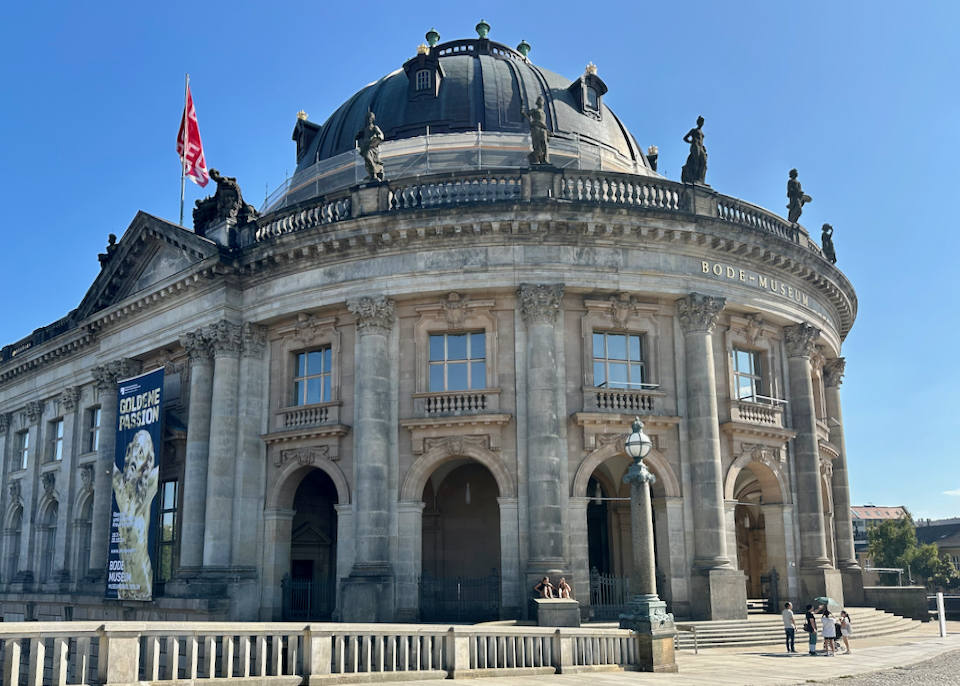
The Bode-Museum on Museum Island is worth a visit for its exceptional collection of sculpture, Byzantine art, and coins spanning from antiquity to the 18th century.
Berlin Travel Tips
- Berlin Brandenburg Airport opened in 2020 in Schönefeld, 11 miles (18km) south of the city center – it’s now the sole airport serving the German capital. As the third largest airport in Germany, it’s well connected to cities all over Europe, plus offers non-stop flights to New York (Delta) and Newark (United). It’s relatively easy to get to the city by train, with frequent Airport Express (FEX) and regional S-Bahn services zipping to Potsdamer Platz, Alexanderplatz, and Berlin Hauptbahnhof (Berlin main train station) in around 30 minutes – you’ll have to change at those stations or take a taxi to get to your hotel. Taxis from the airport will cost at least €50 to the city center (on the meter).
- There are several tourist passes on offer for Berlin – as always, these are a good value only if you intend to do a lot of sightseeing in a short amount of time. The Berlin WelcomeCard is the official pass offered by the tourist bureau, offering free public transport and reduced-price admission to over 200 museums and sights for 2–6 days (from €24 for 2 days). If you intend to do a lot of sightseeing (8 hours a day), opt for the “All-inclusive” version (from €69 for 2 days), which gives free entry to many sights and free use of the hop-on hop-off tourist buses in addition to public transport.
- Free wi-fi is available at Berlin Brandenburg Airport, and at cafés, train stations, and museums through the city itself. Free wi-fi (without registration) is also supplied at more than 5,000 wireless hotspots throughout the city, primarily via “PUBLIC WIFI” and the Freifunk Berlin network (look for “berlin.freifunk.net”).
- You’ll find many more English speakers in cosmopolitan Berlin than in small-town Germany, but not everyone working in shops and restaurants will understand you. Try to learn a few words and numbers in German before you go.
More Berlin Neighborhoods
We’ve covered our favorite neighborhoods to visit and stay in more detail above, but with more time these districts are also worth checking out:
- Schöneberg: South of the city center, Schöneberg was once a bohemian magnet, home to Christopher Isherwood in the 1930s and David Bowie in the 1970s. Today it’s best known for the popular Winterfeldtplatz farmers’ market (Saturday 8am–4pm), a thriving LGBT scene, and vast green spaces like the Tempelhofer Feld (the old airport) and Natur Park Südgelände. On the district’s northern edge is Café Einstein Stammhaus, Berlin’s most historic café, while Rathaus Schöneberg is the town hall where President John F Kennedy gave his famous “Ich bin ein Berliner” (“I am a Berliner”) speech in 1963. The Grimm Brothers (authors of the famous fairytales) are buried (with matching monuments) in St. Matthäus Kirchhof cemetery. The best hotels in the northern end of the district (convenient for tackling the rest of the city) include Hotel Sachsenhof, Lindemann’s, and LGBT-friendly ArtHotel Connection.
- Neukölln: Visit this southern district to sample Berlin’s most hip bars, galleries, shops and cafés. It’s an edgy neighborhood with an artsy reputation, known for its dynamic Turkish community, eclectic restaurants, and bar scene (checkout Ratzeputz or TiER for cocktails). Highlights include the elegant Orangerie Neukölln café and the “Turkish Market” on the Maybachufer. Of the few hotels out here, Estrel Berlin is the best.
- Lichtenberg: History buffs will want to check out this eastern district to visit the Stasi Museum (former headquarters of East Germany’s secret police), the Hohenschönhausen Memorial, site of the notorious East German political prison, and the Friedrichsfelde Cemetery, resting place of leading German socialists Wilhelm Liebknecht and his son Karl, Rosa Luxemburg, and controversial founder of East Germany, Walter Ulbricht. The Museum Berlin-Karlshorst preserves the site of the German surrender in 1945. For families, Tierpark Berlin is the city’s primary zoo and Europe’s largest wildlife park. There’s not much benefit in staying out here, but H24 Berlin-Lichtenberg is modern and good value.
- Potsdam: The home of the Prussian kings and German emperors lies just over 20 minutes by train from Berlin Central Station. This leafy suburban city makes for an easy and enjoyable daytrip, with plenty to see, from the vast Schloss Sanssouci complex to the historic Babelsberg film studios and nearby Max Liebermann Villa. Top hotels here include Hotel Brandenburger Tor Potsdam, Hotel am Grossen Waisenhaus, and Zum Hofmaler. For budget stays it’s hard to beat Quartier SansSouci Hostel.
- There’s not much point in staying near Berlin Brandenburg Airport in the southwestern part of the city unless you have an early flight. If you do need to stay here, the best choice is the uberconvenient Steigenberger (just outside Terminals 1 & 2). Moxy Berlin Airport, a little further away, is usually a bit cheaper but very good. Intercity Hotel is more convenient for Terminal 5.
Summary: My Favorite Hotels in Berlin
My Favorite Berlin Hotels
• 5-Star: Adlon Kempinski
• 4-Star: Wil7
• 3-Star: Grimm’s
• For Families: Hollywood Media
• For Couples: Mandala
• Hotel Pool: Oderberger
• Near Airport: Steigenberger
• Train Station: Motel One
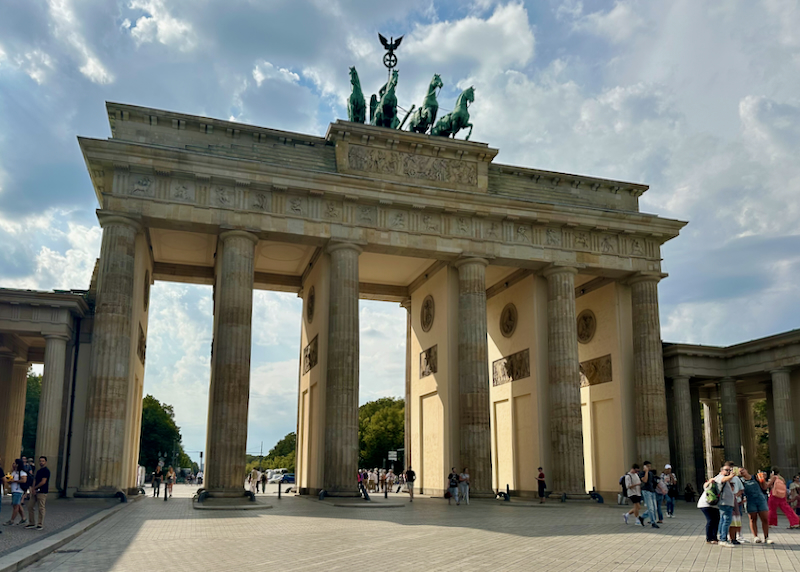

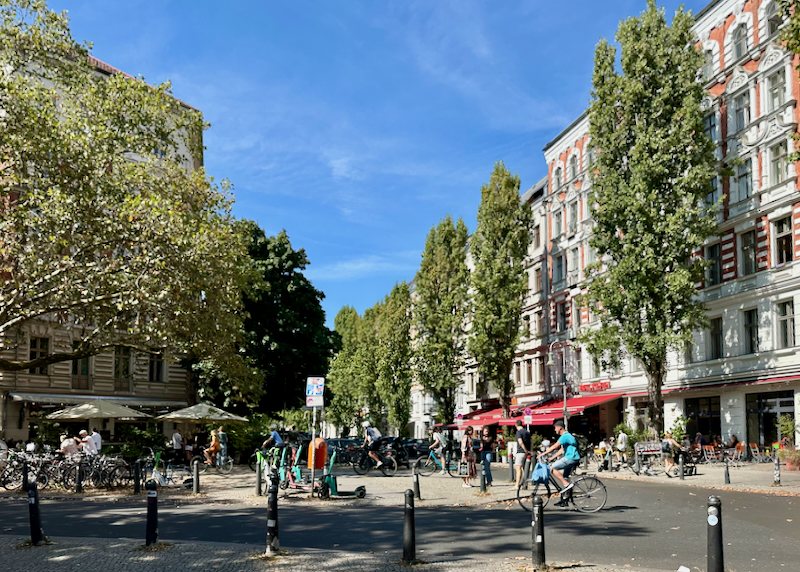
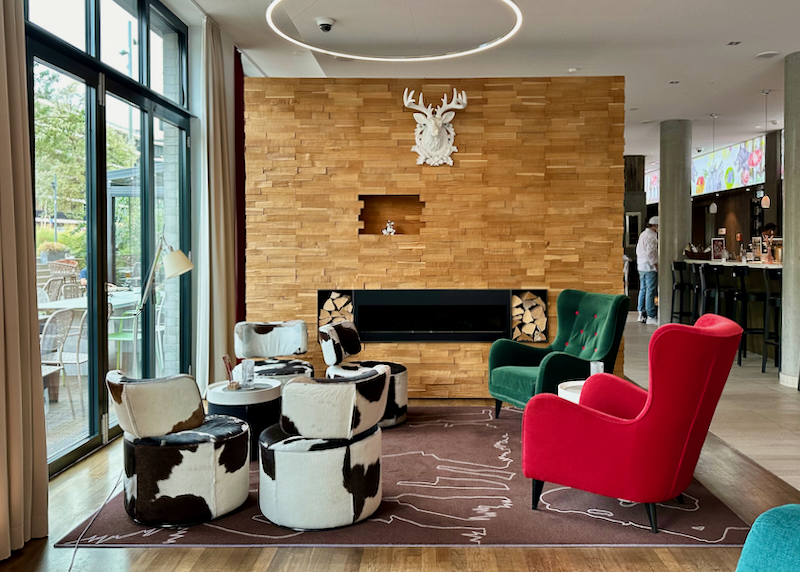

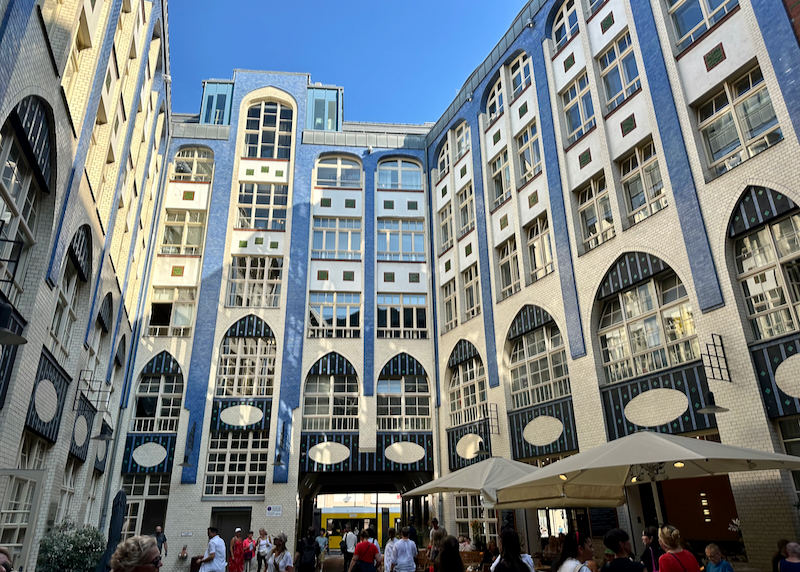
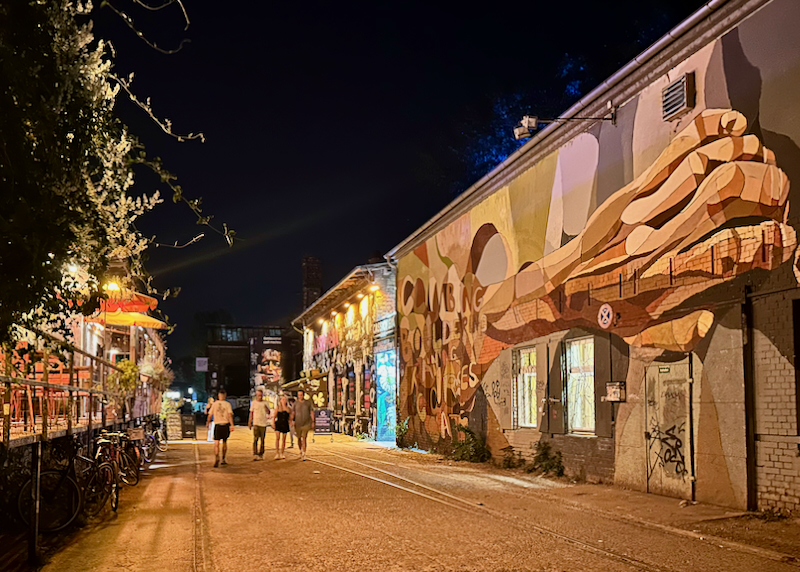
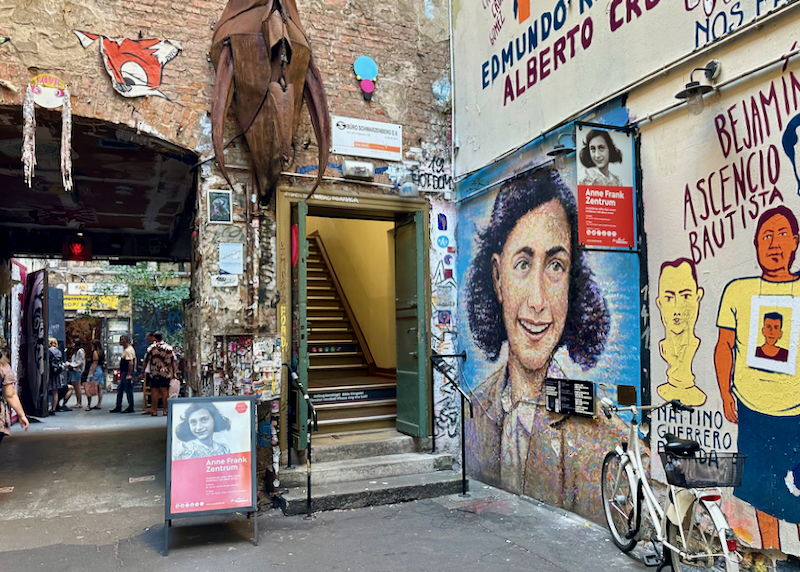


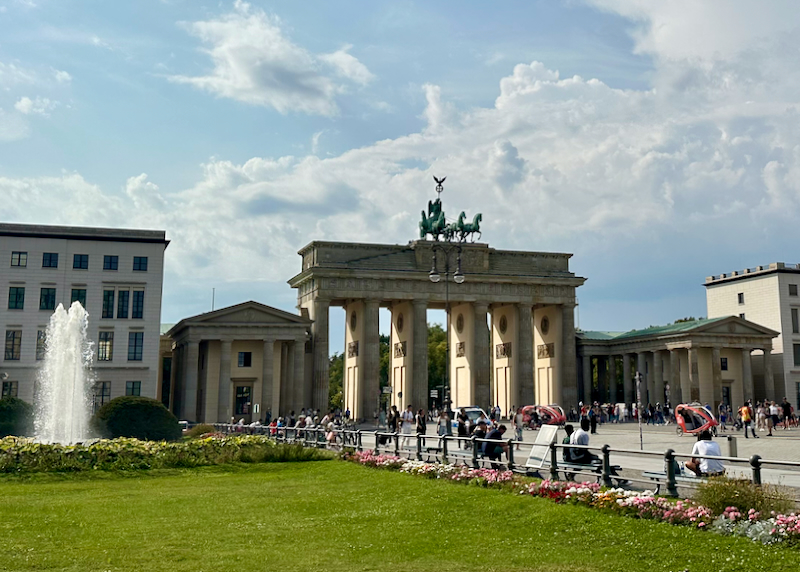
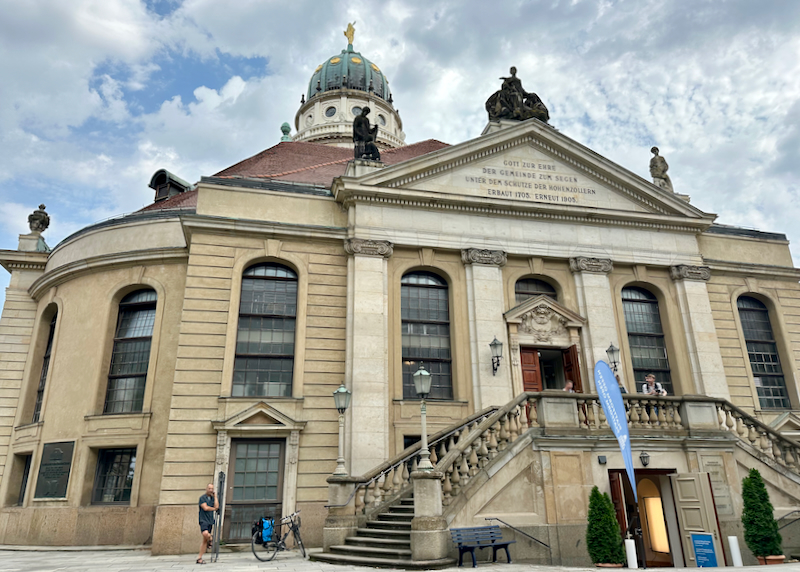

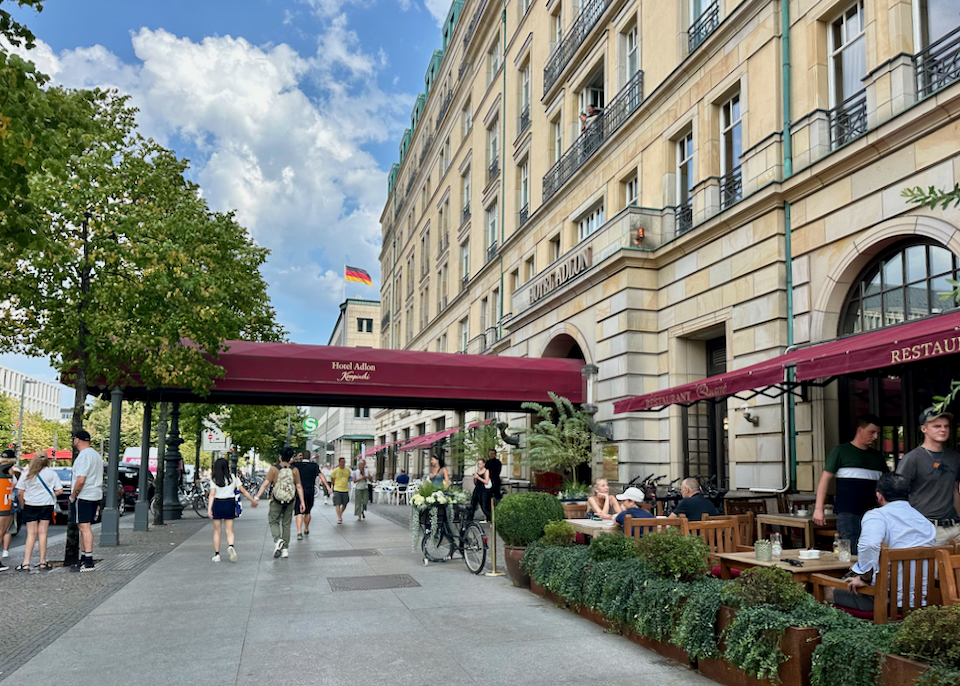
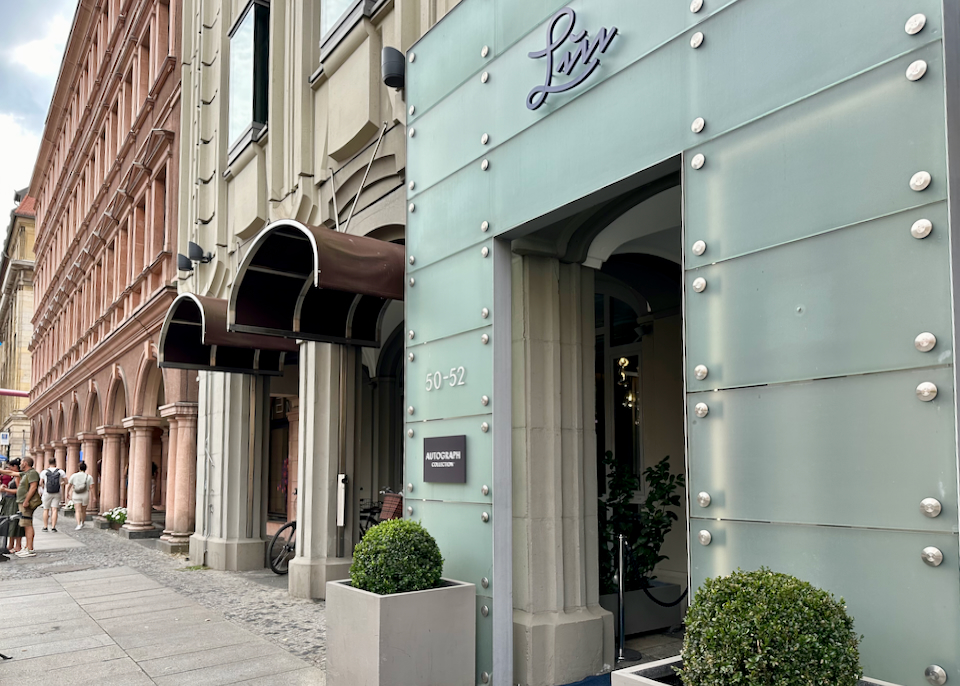
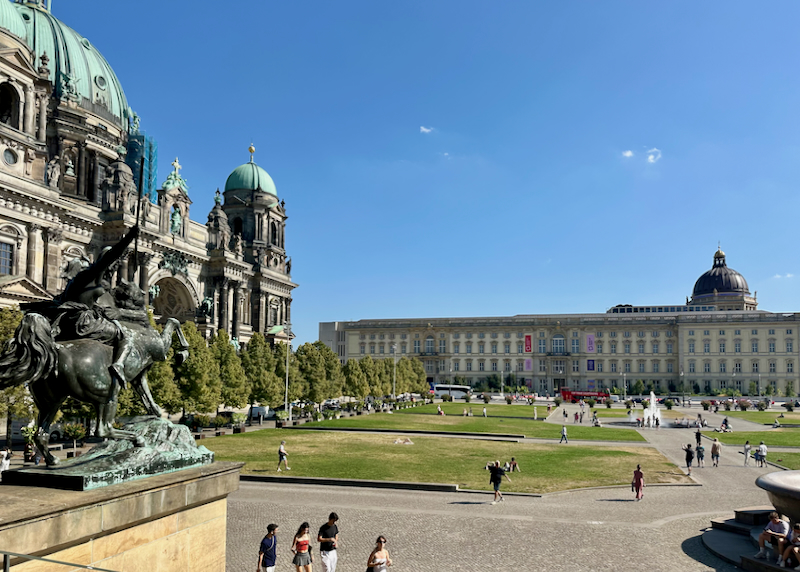
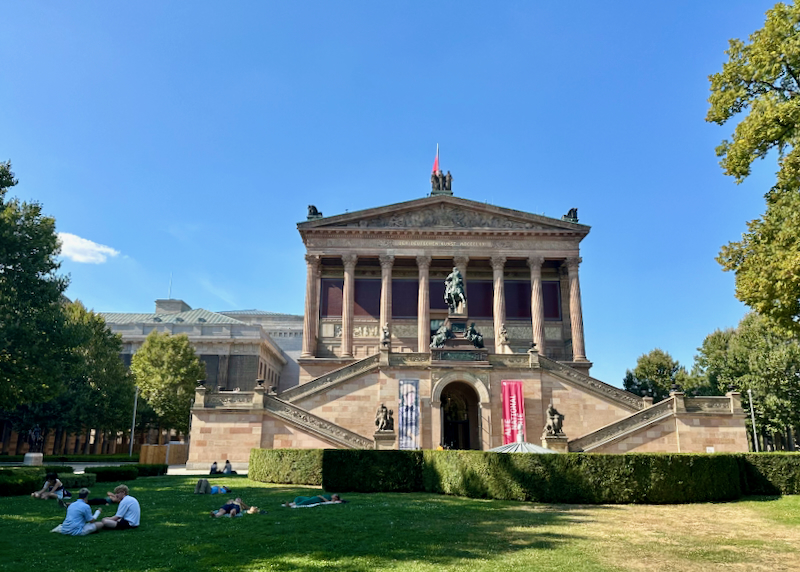
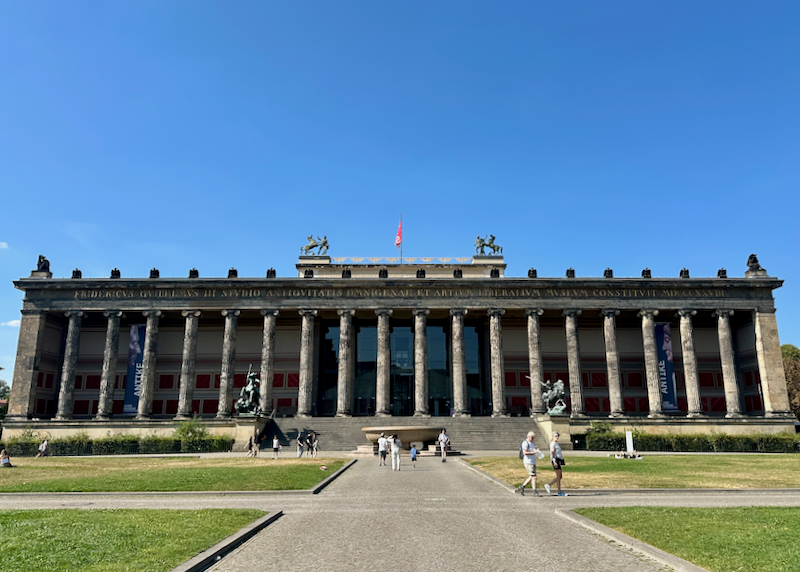
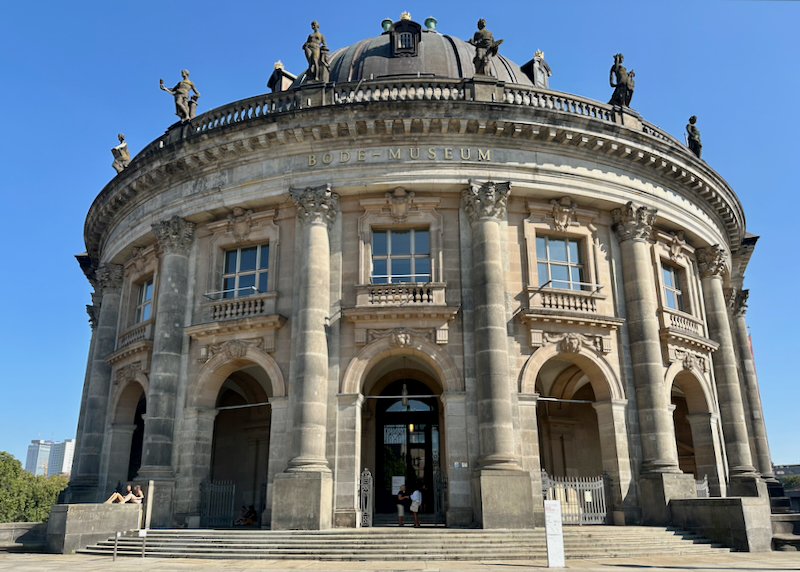
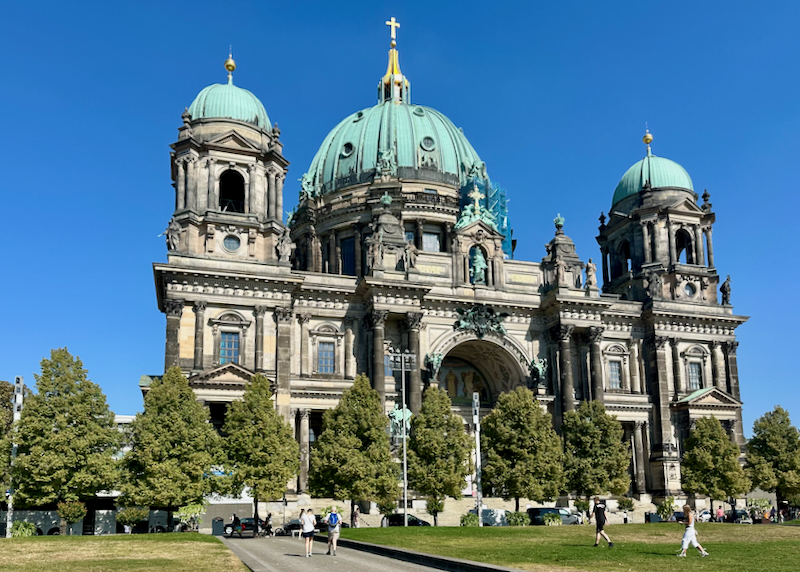


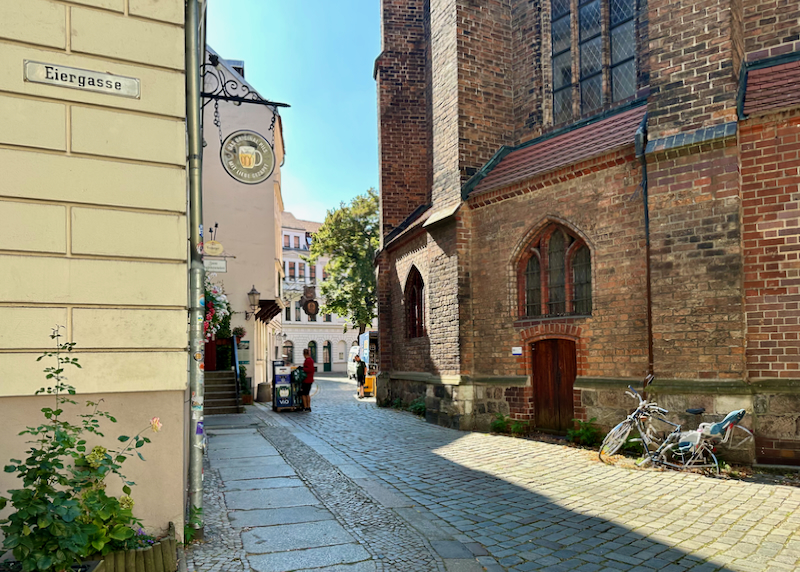
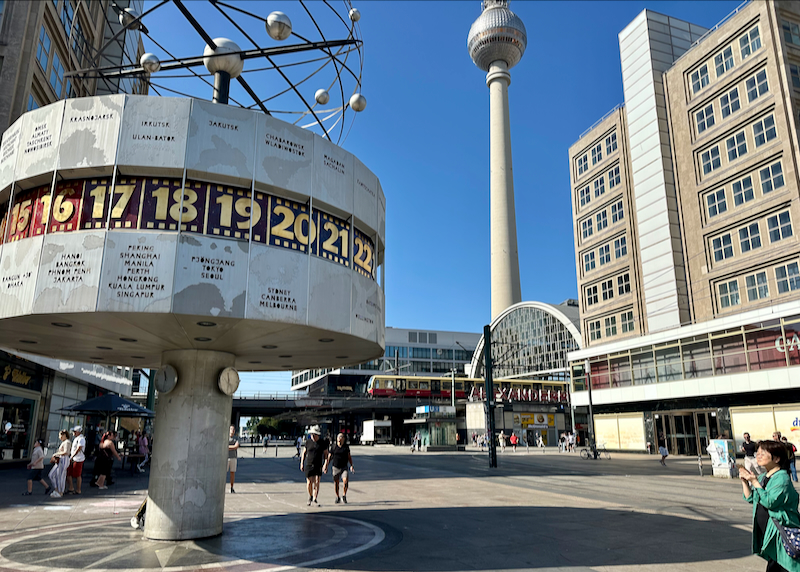
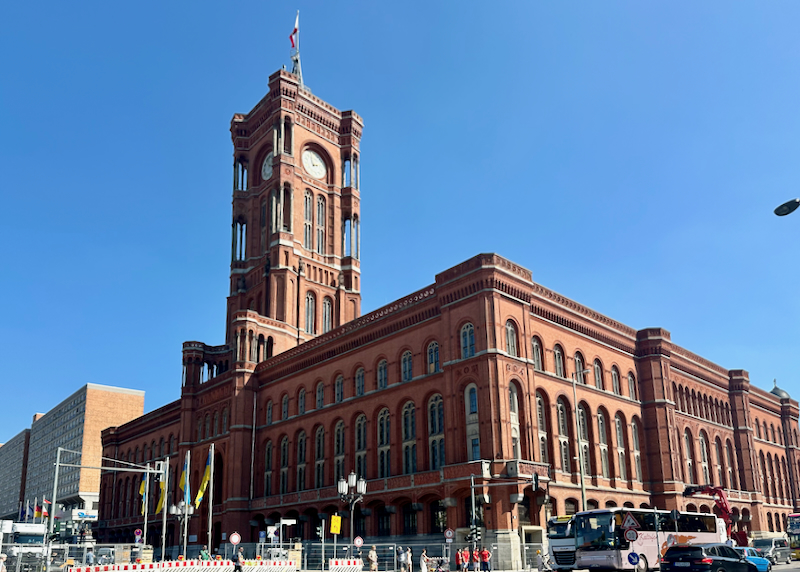
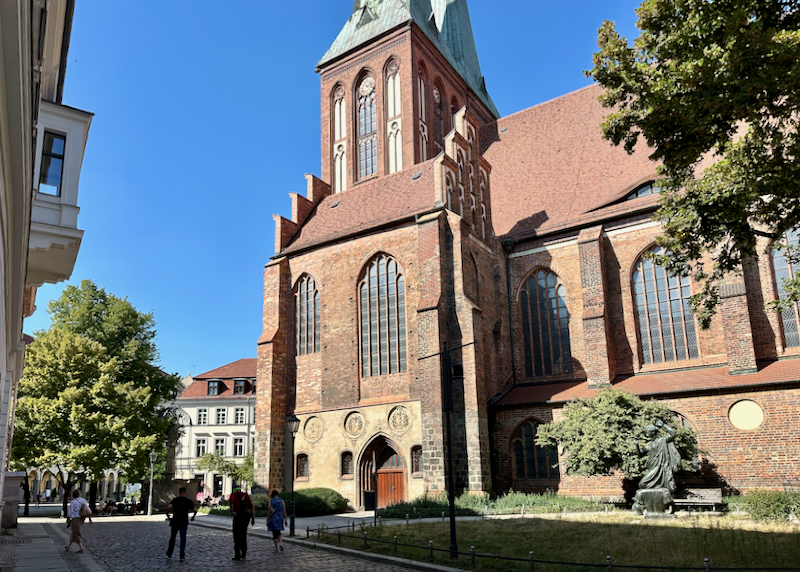

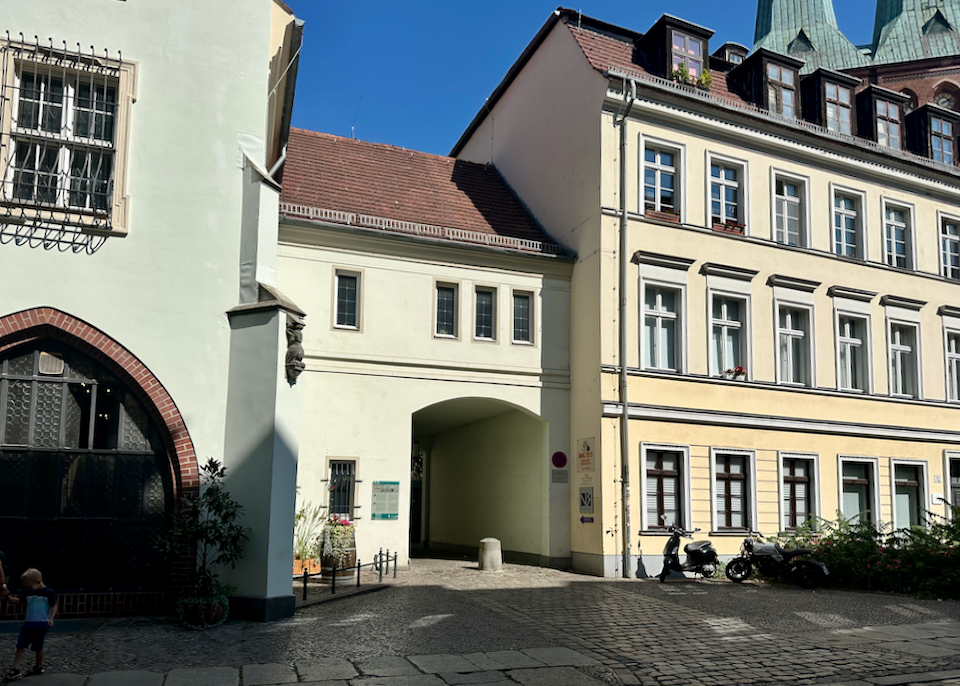

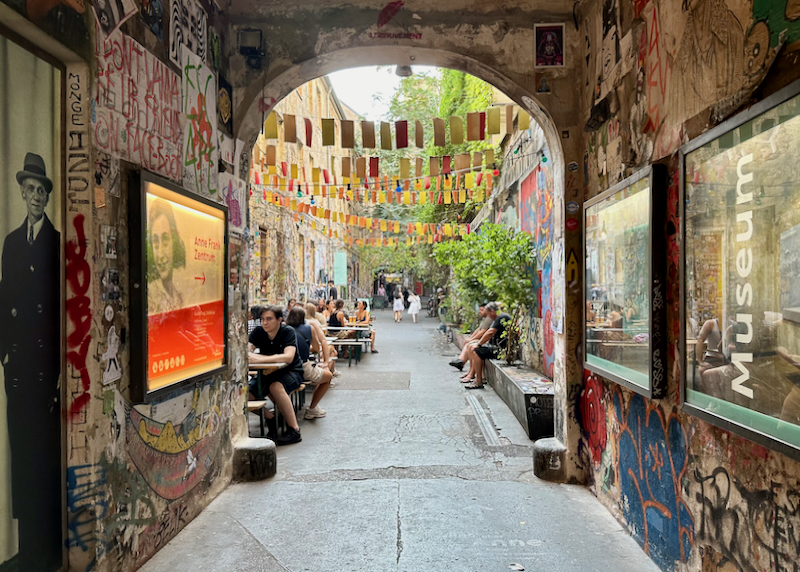
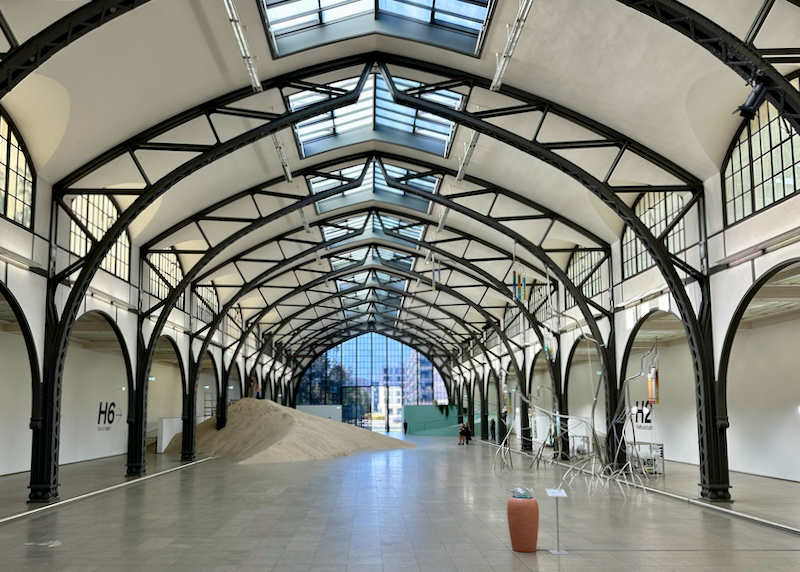
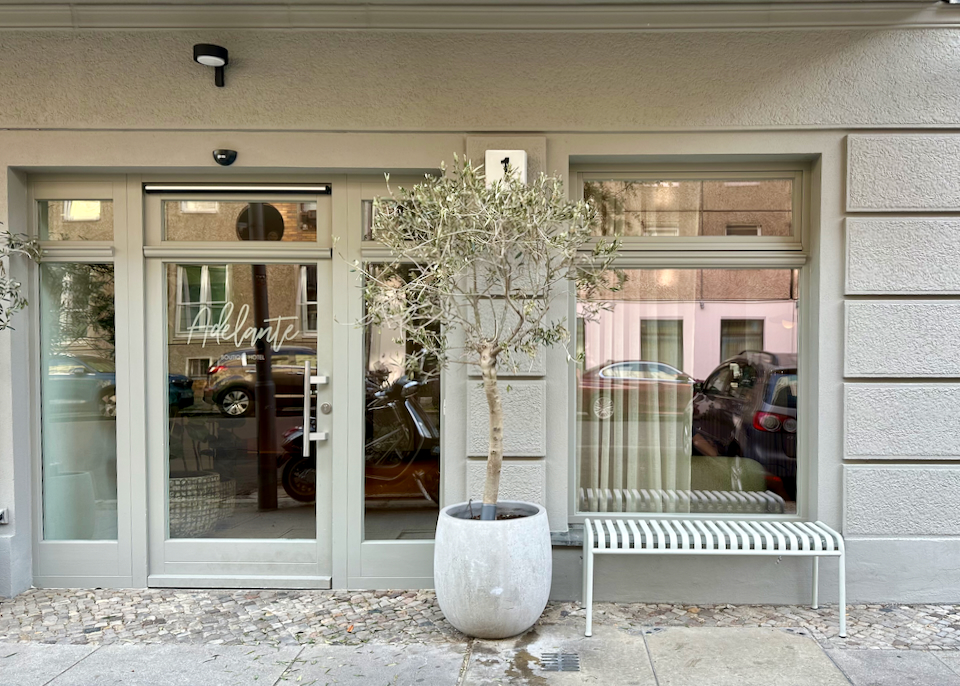
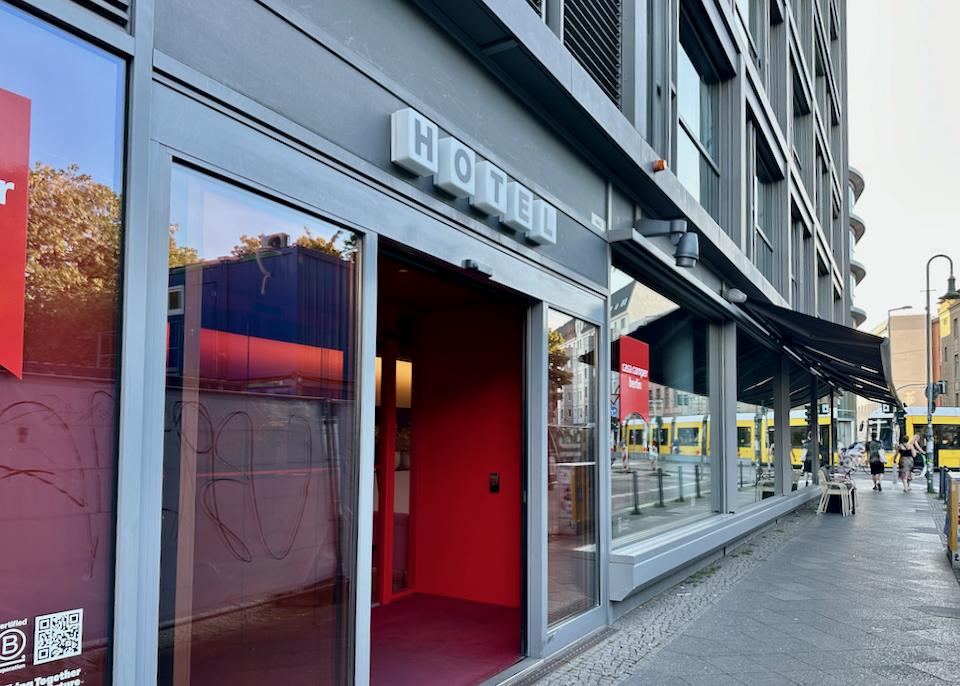
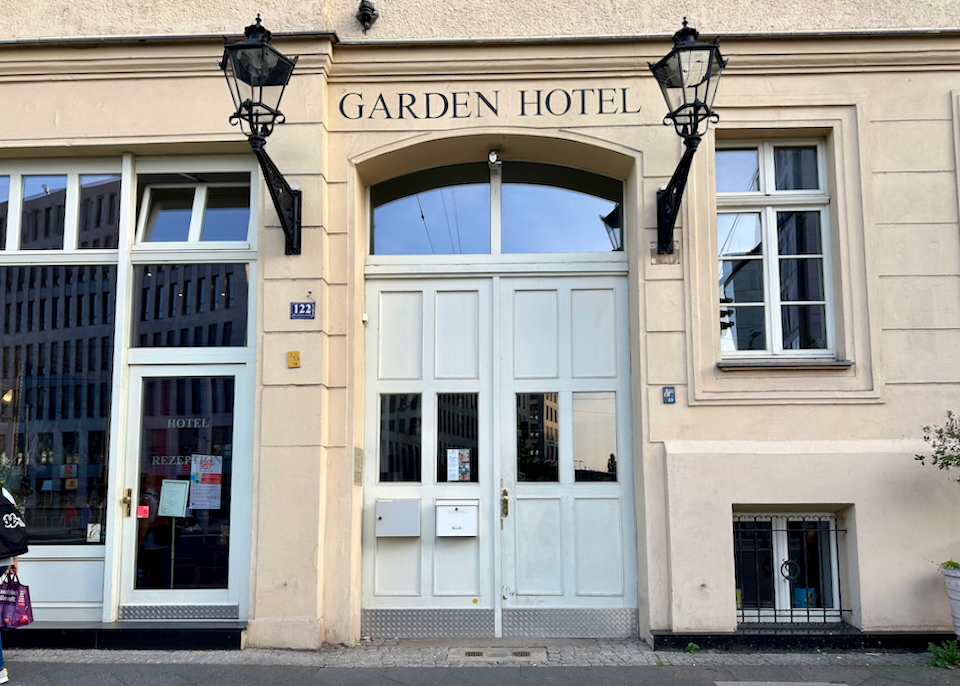
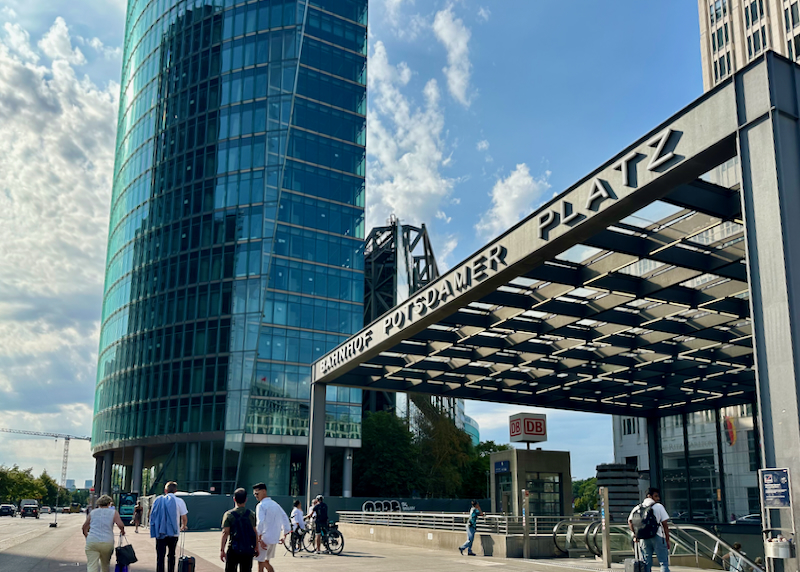

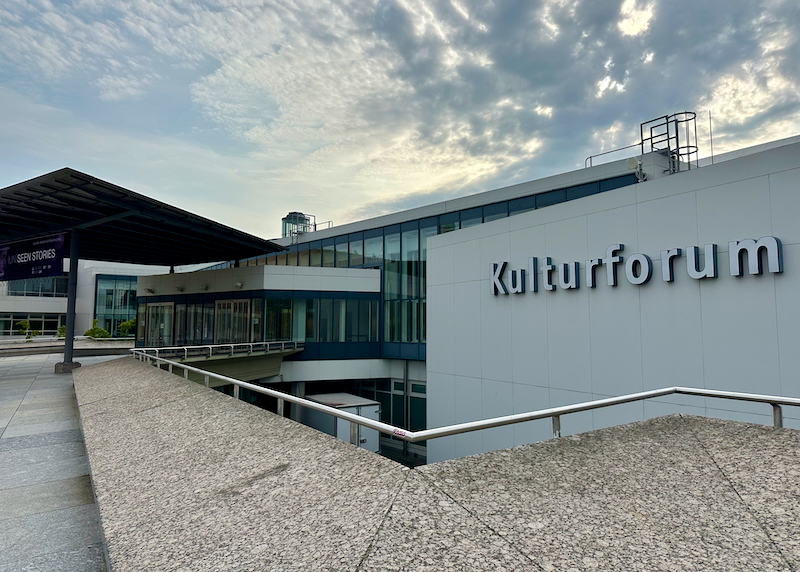
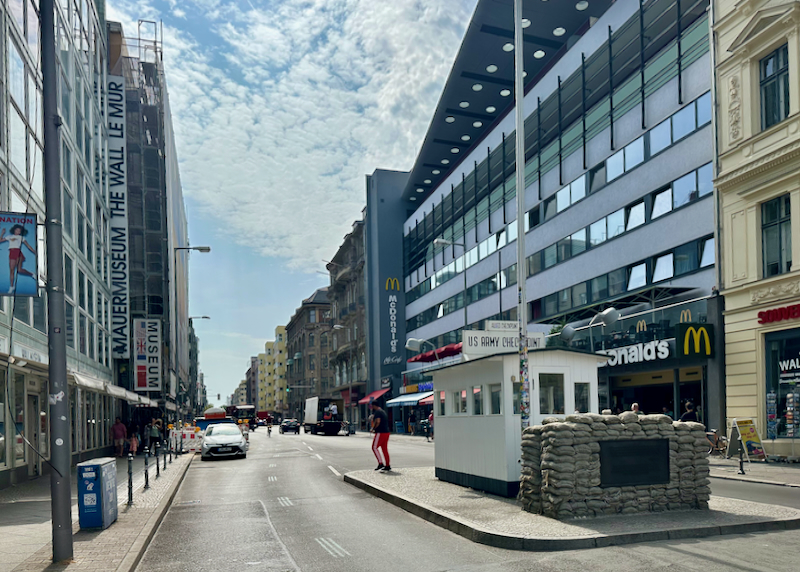
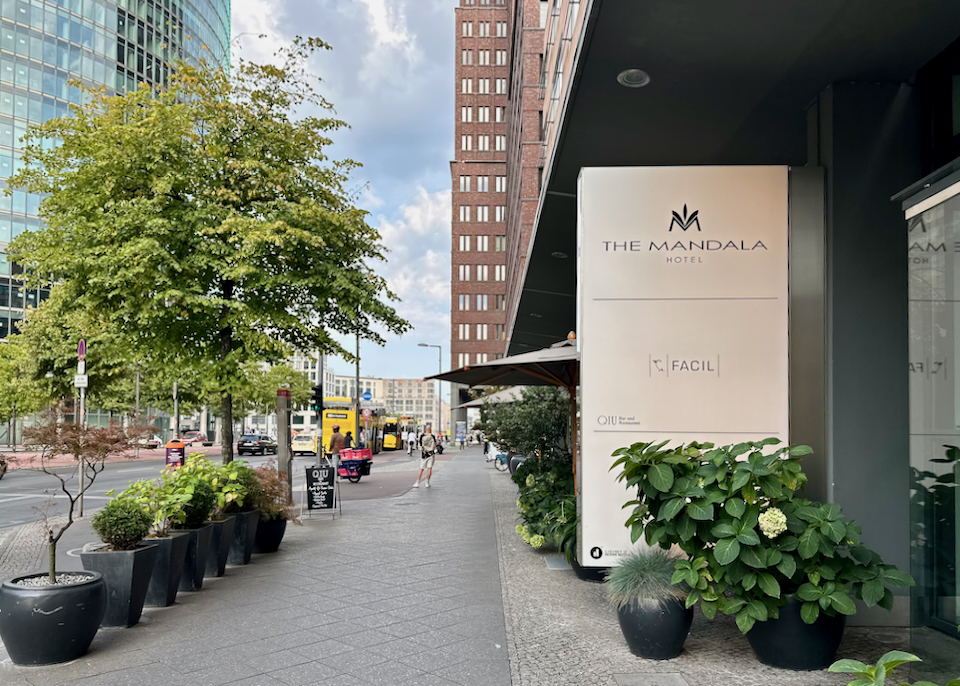
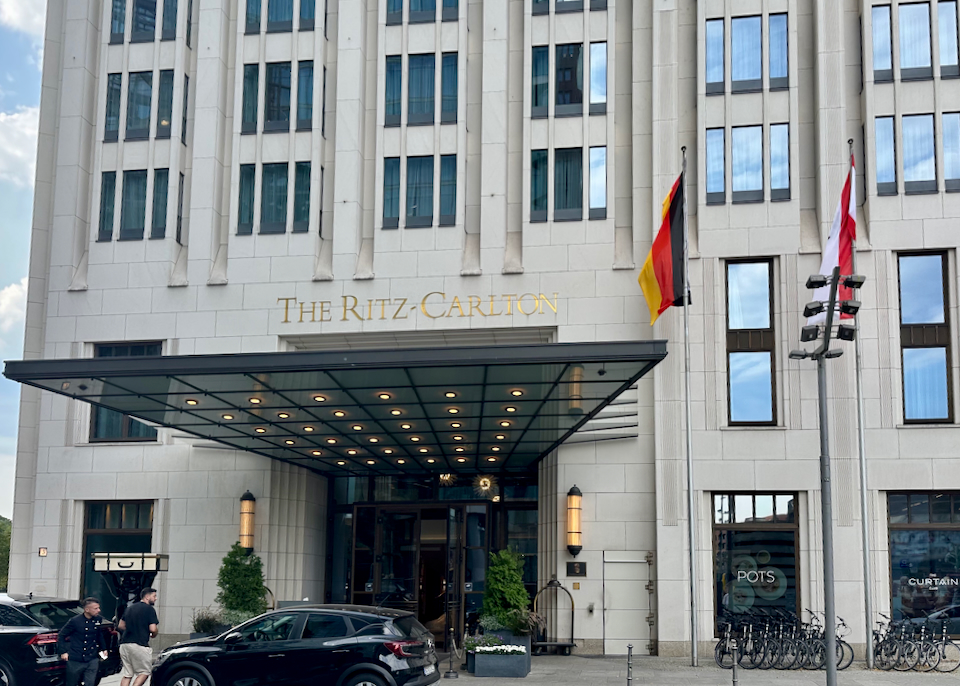
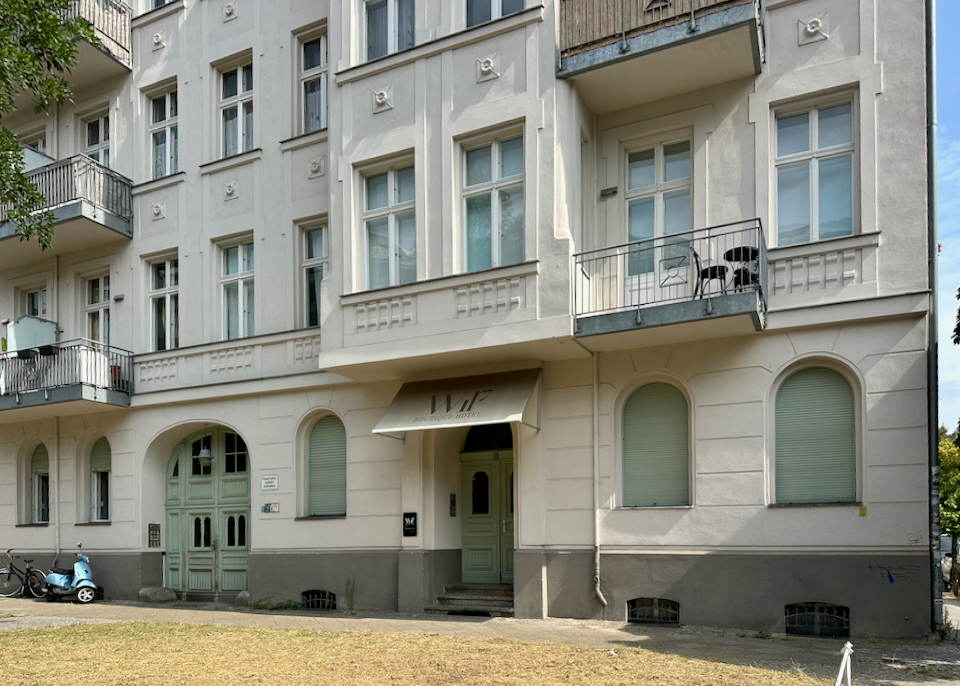
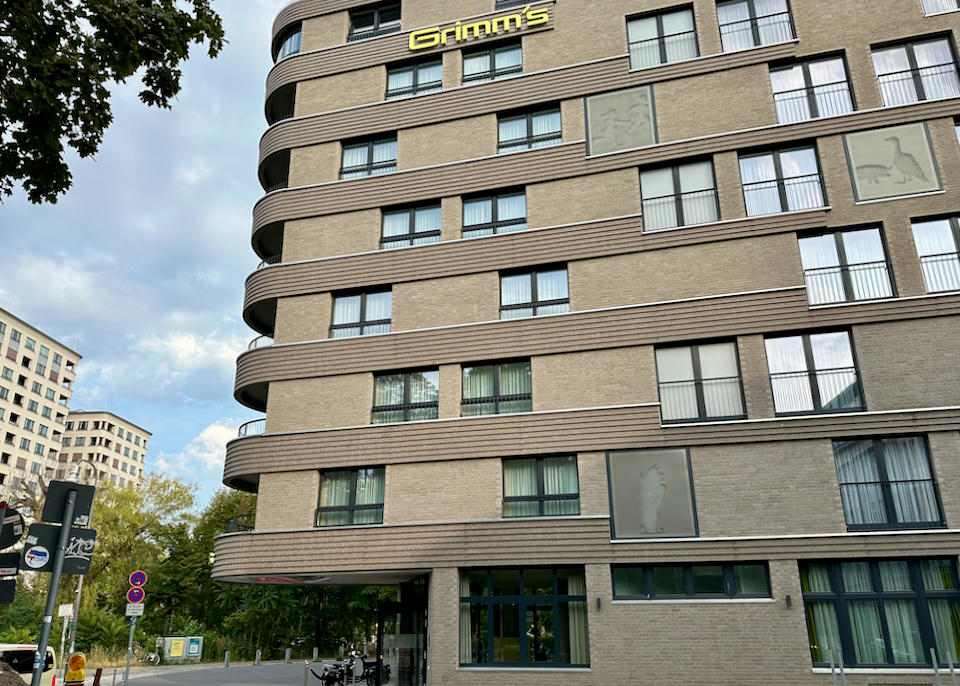
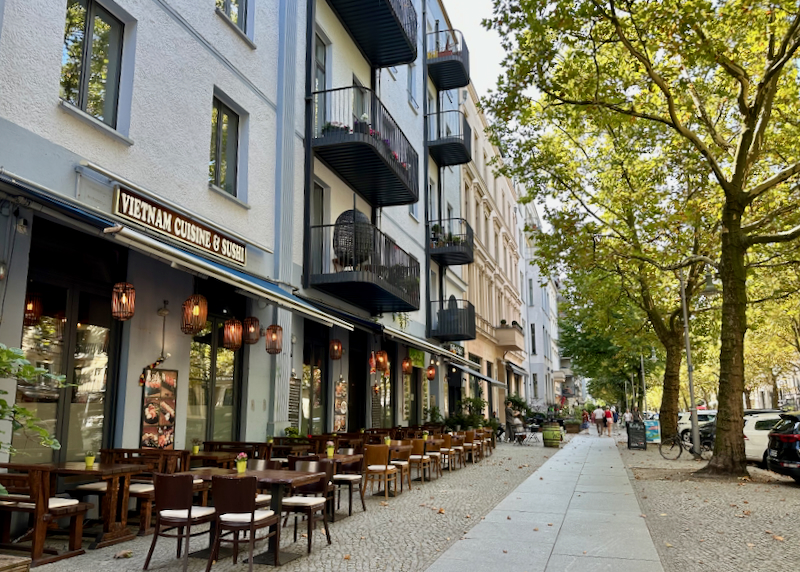

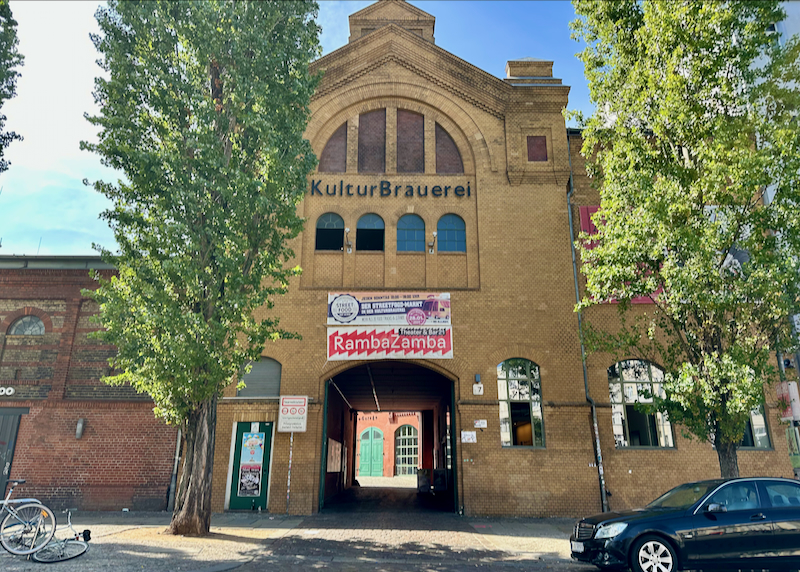


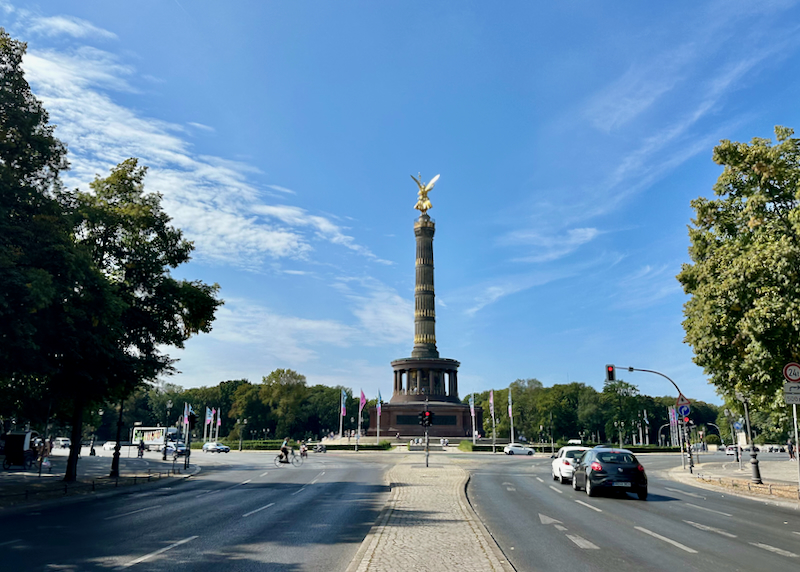
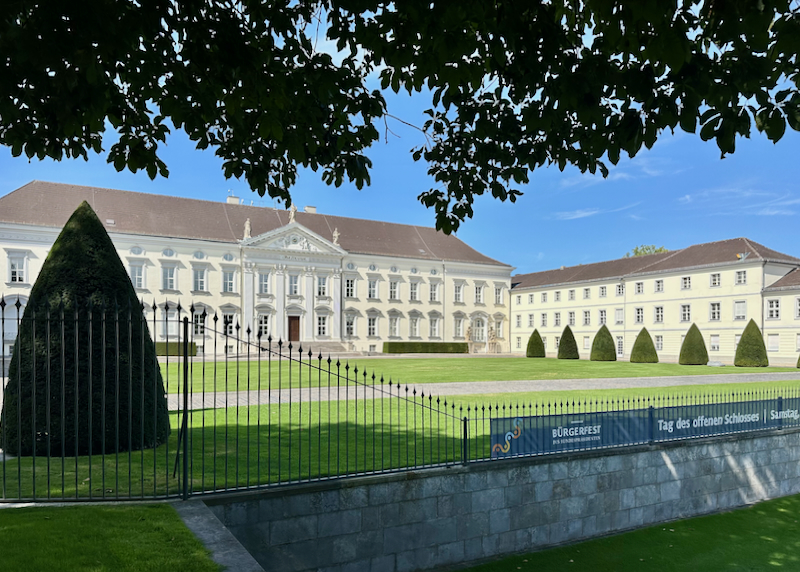
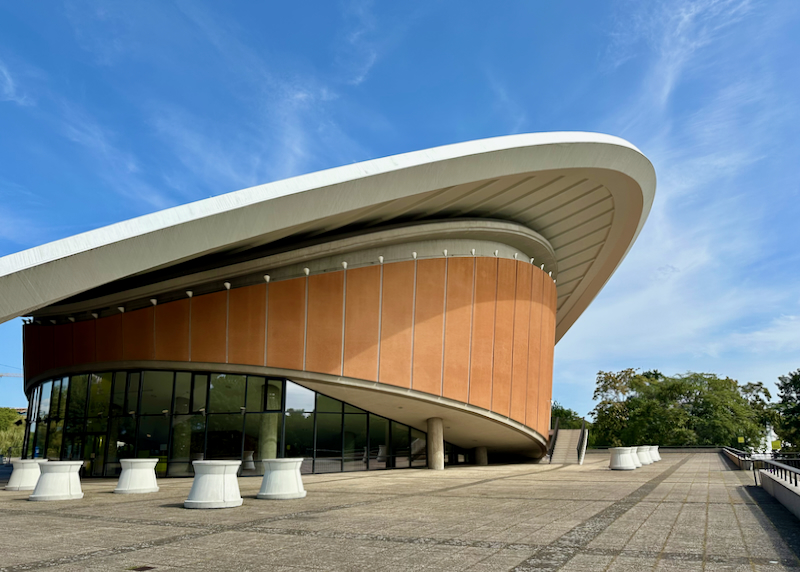
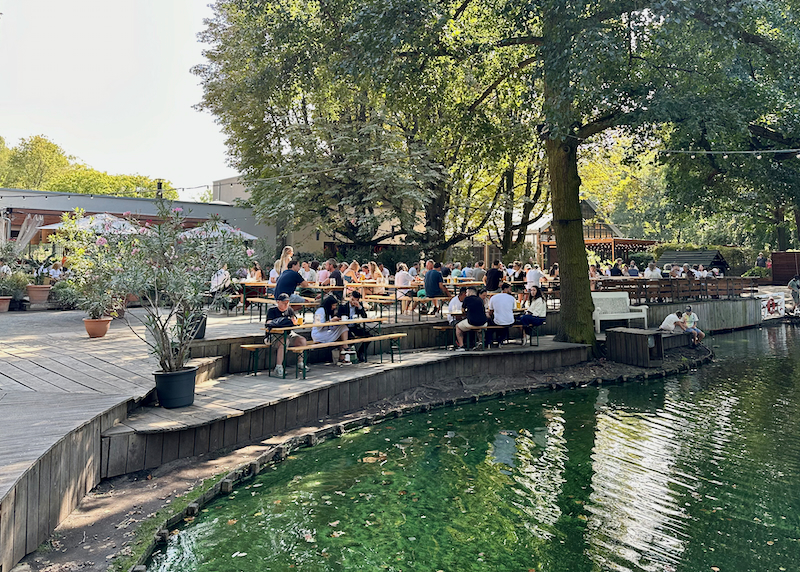
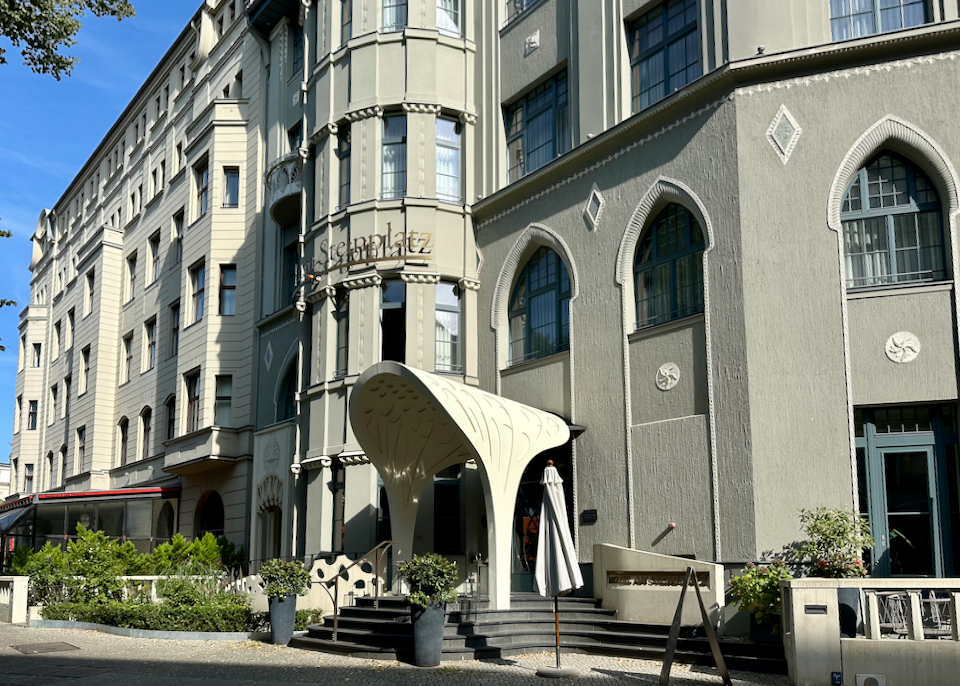

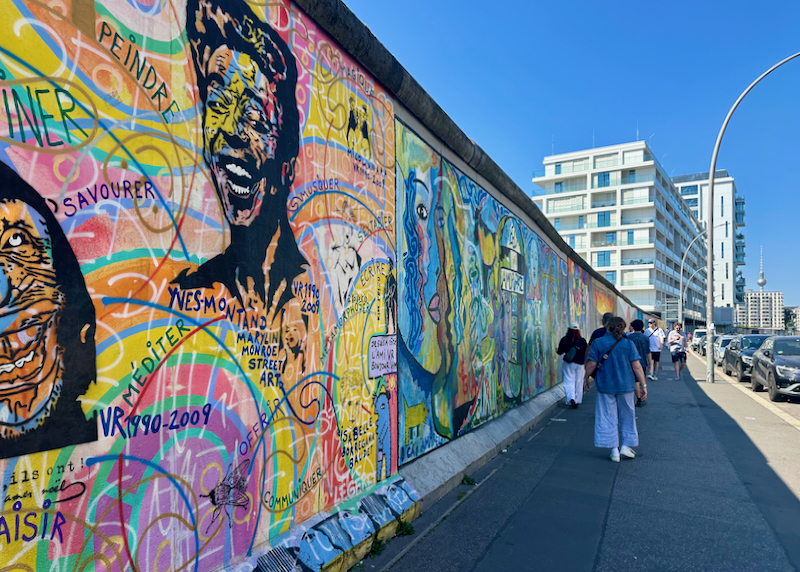
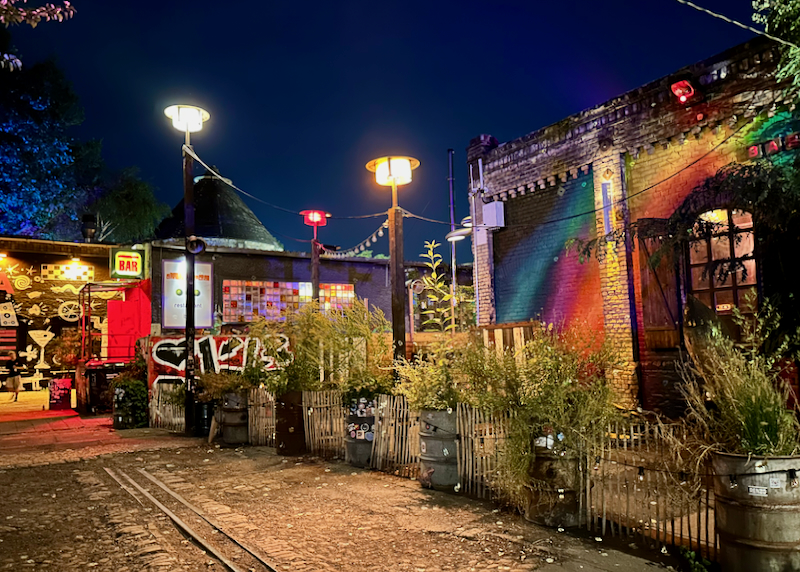
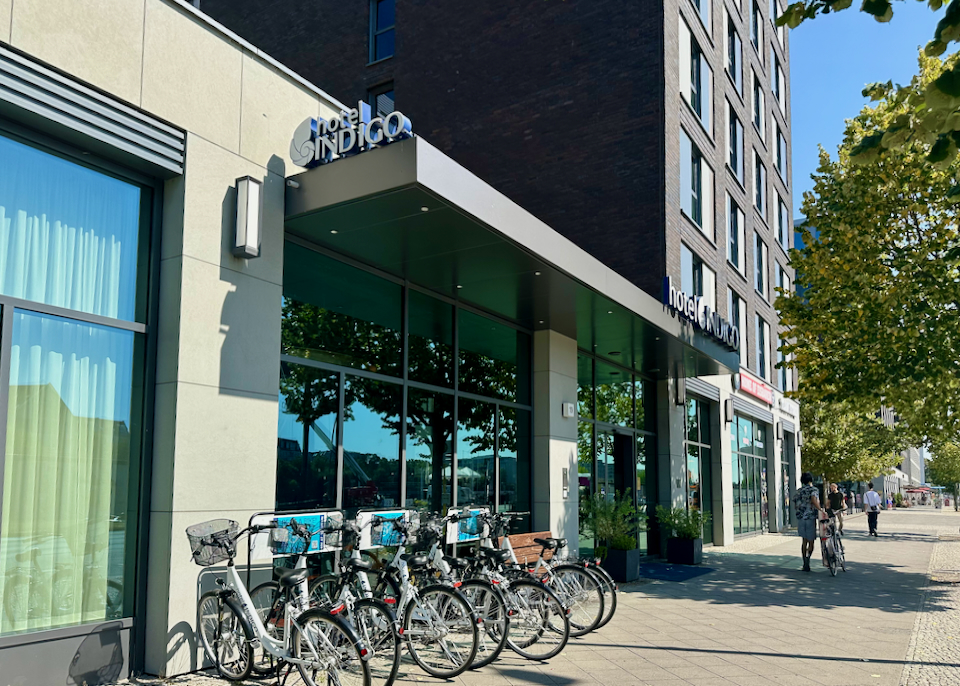

About Santorini Dave